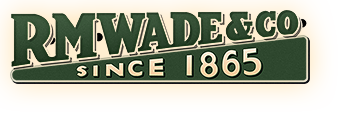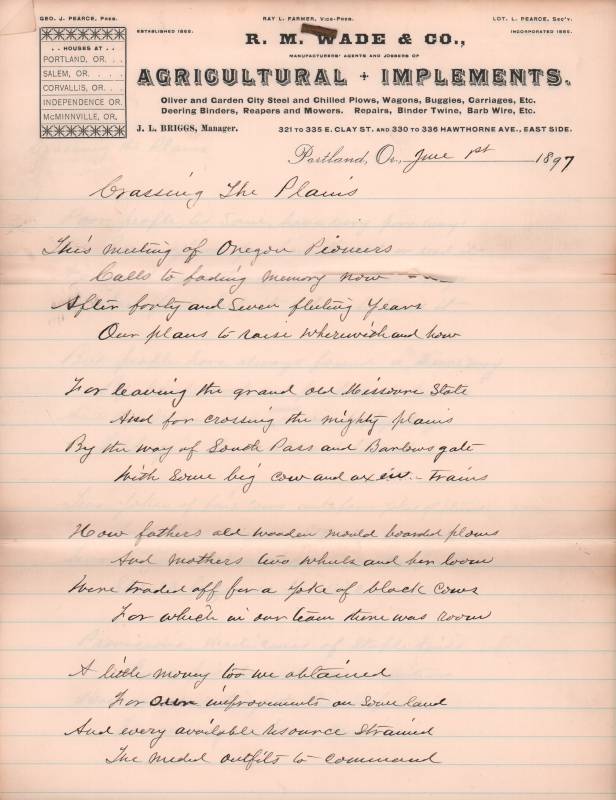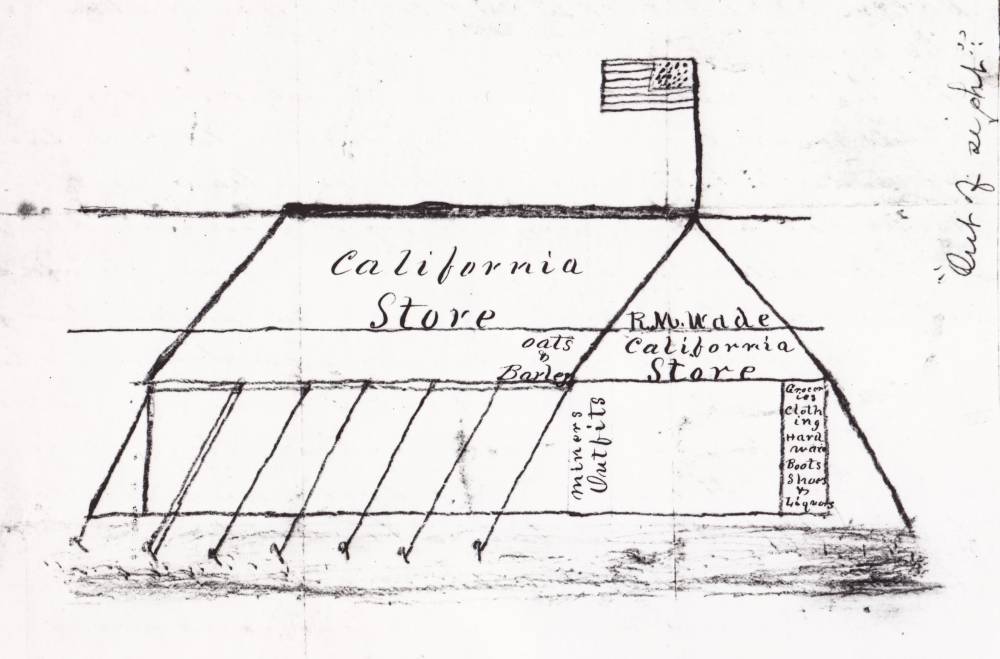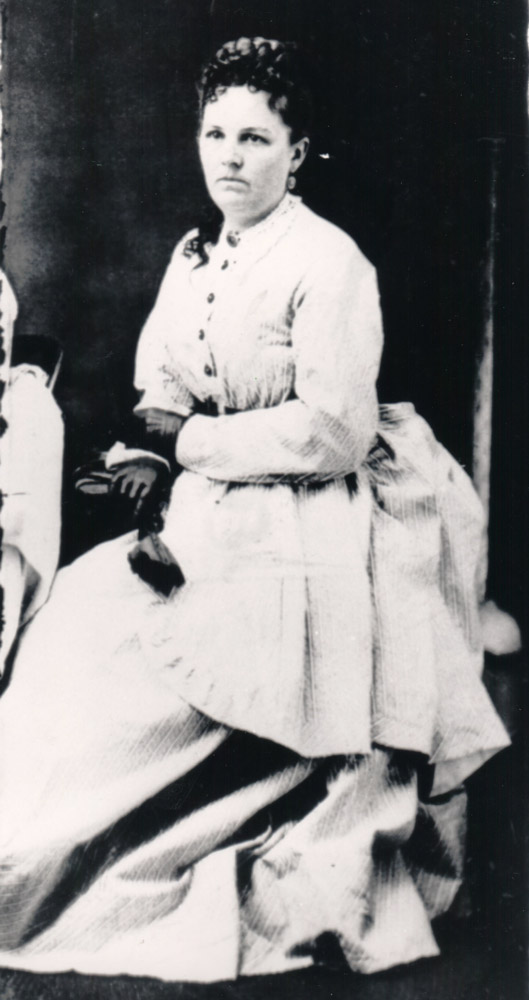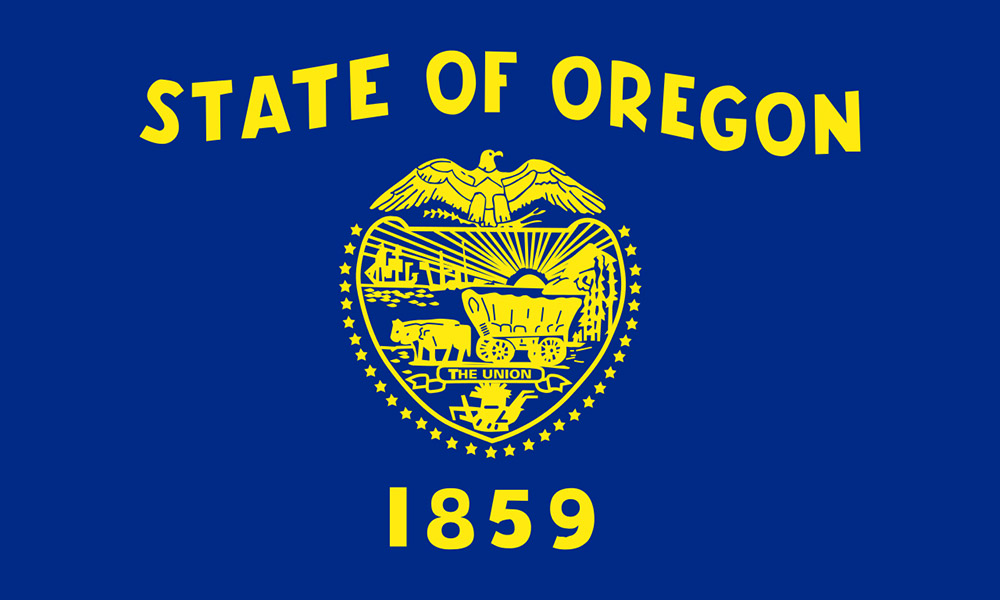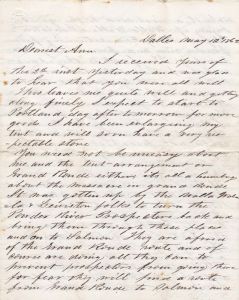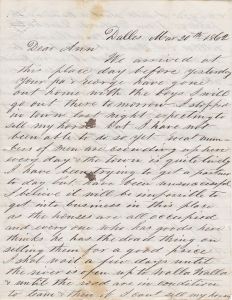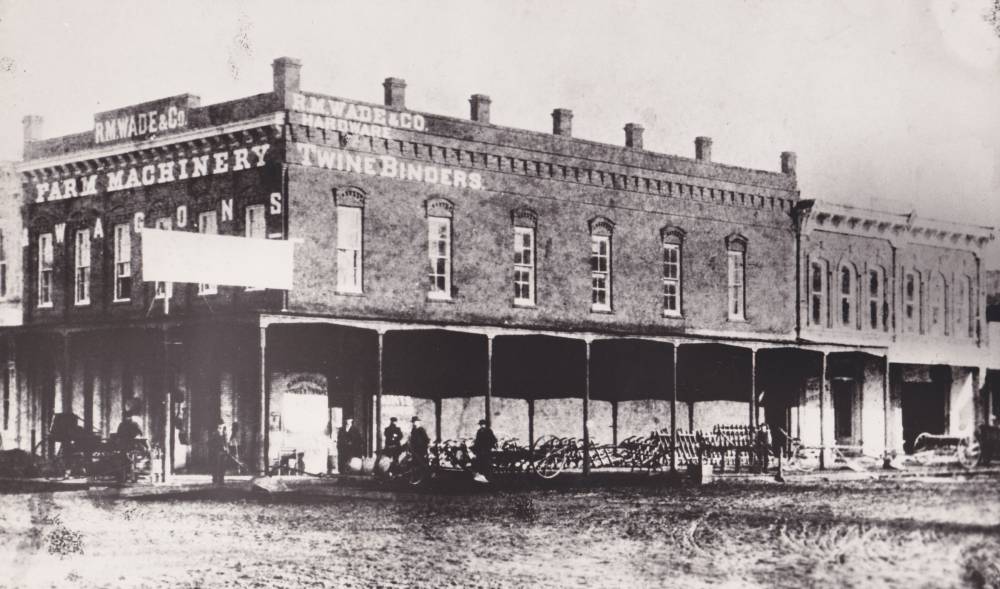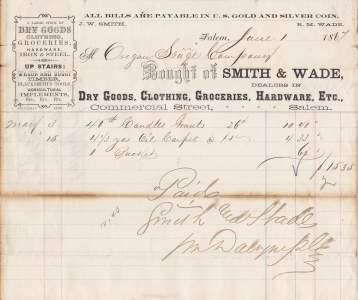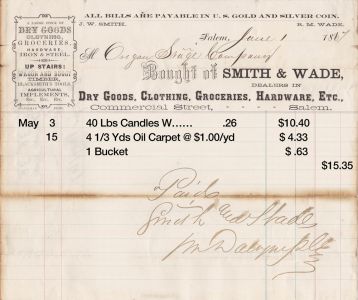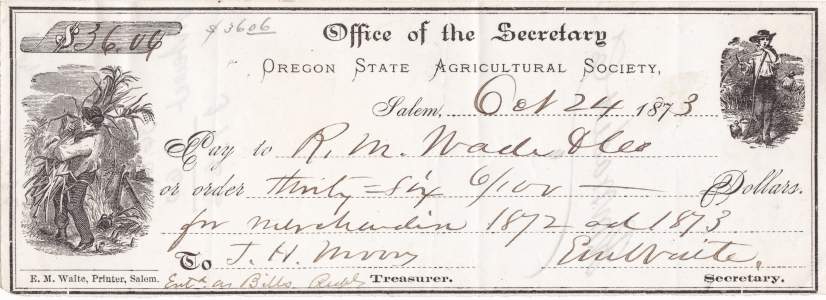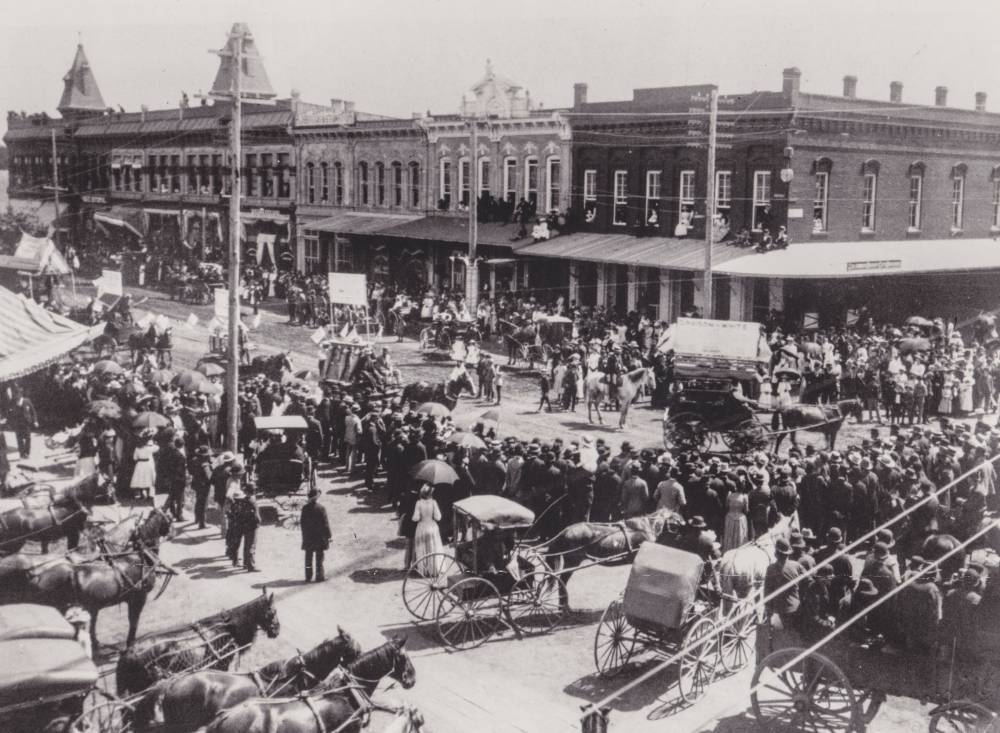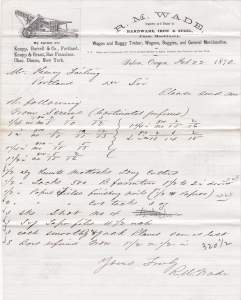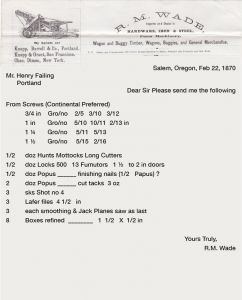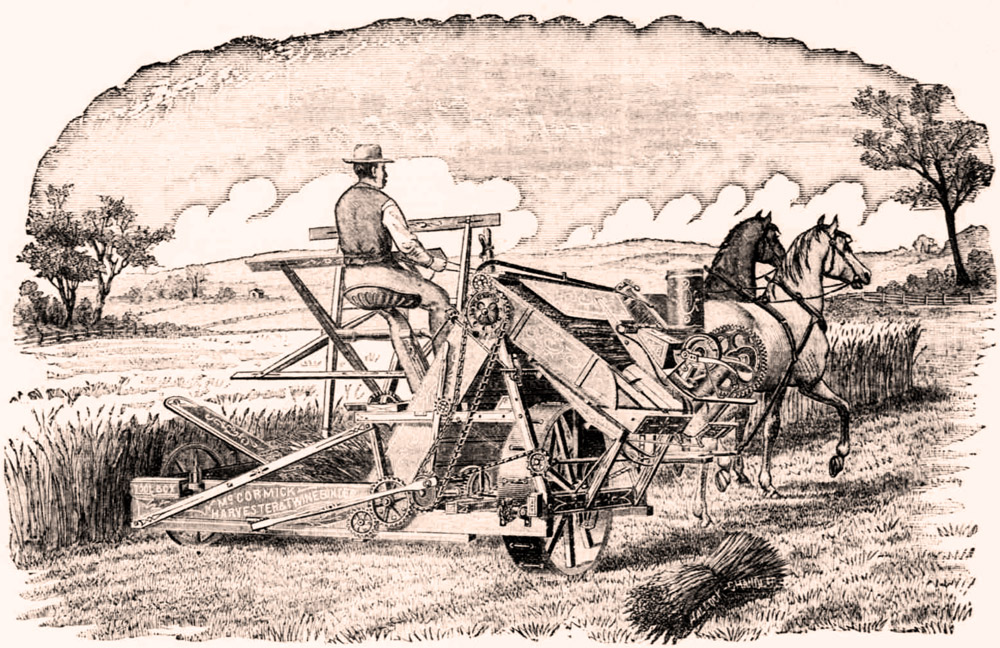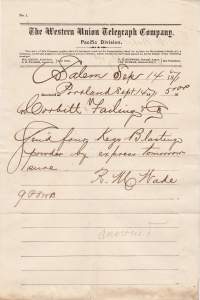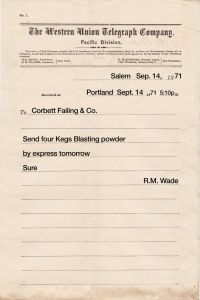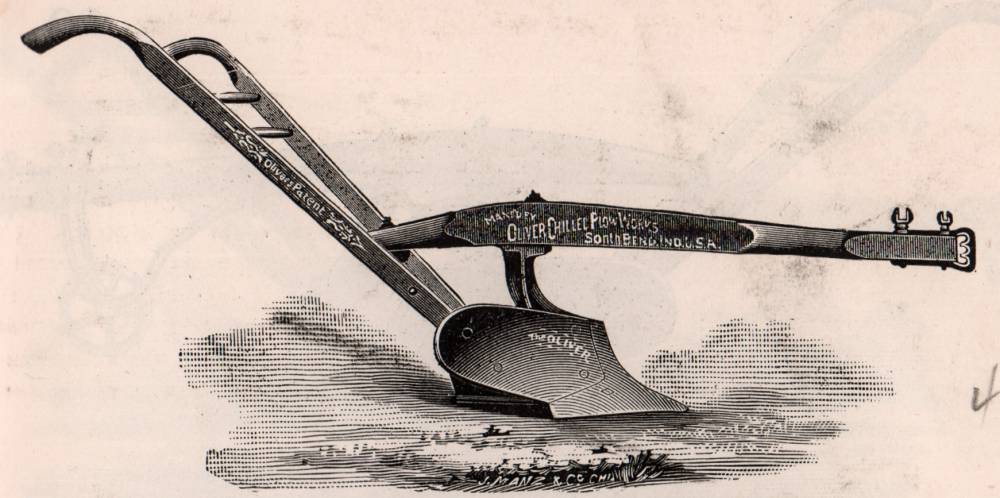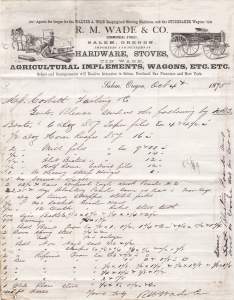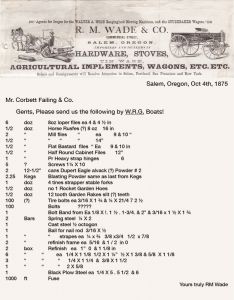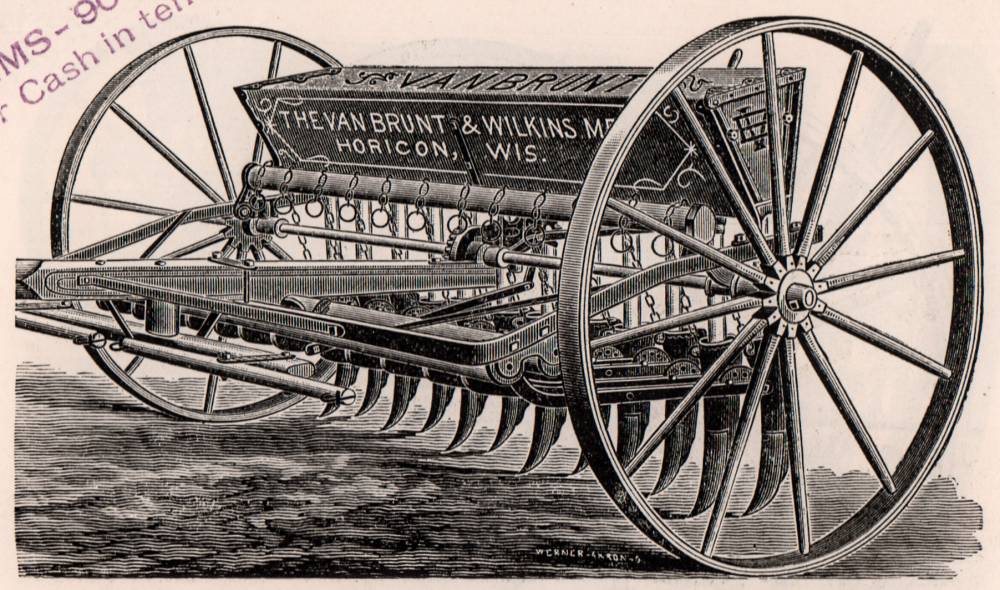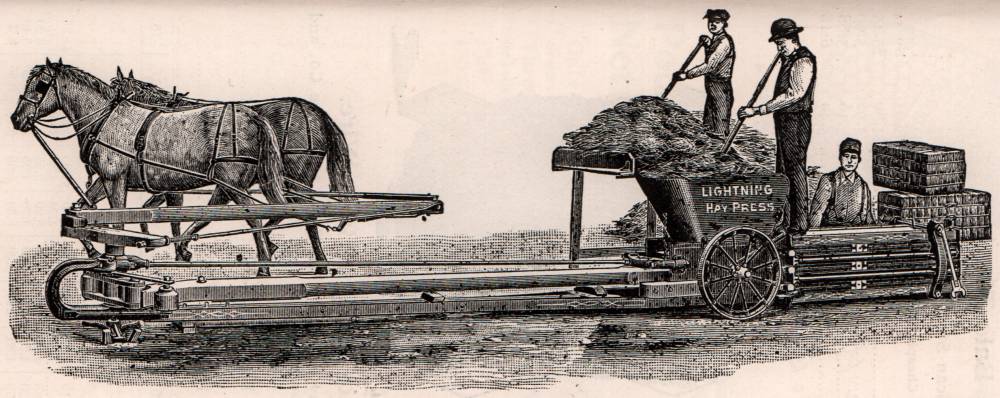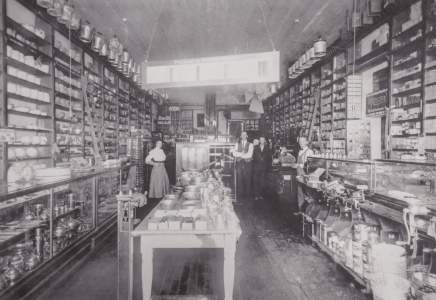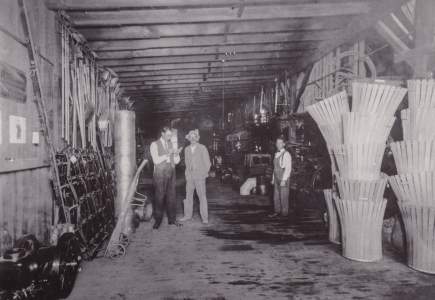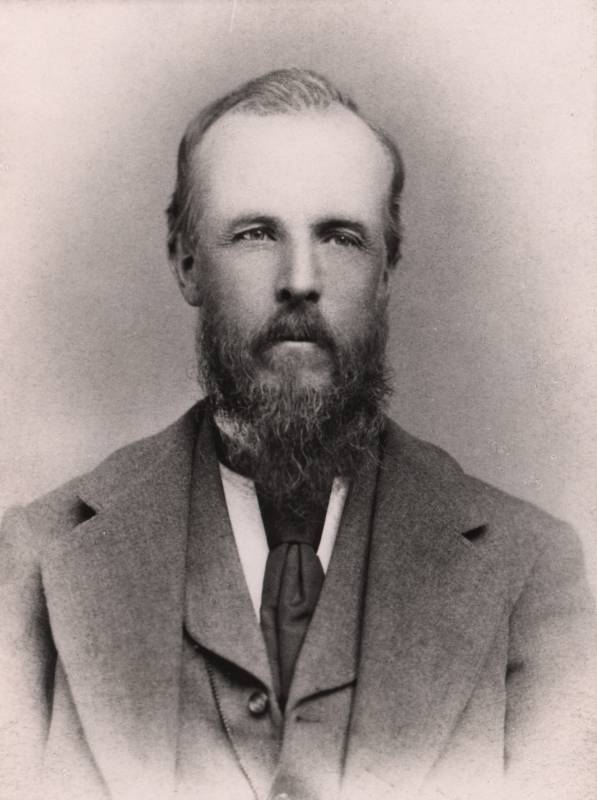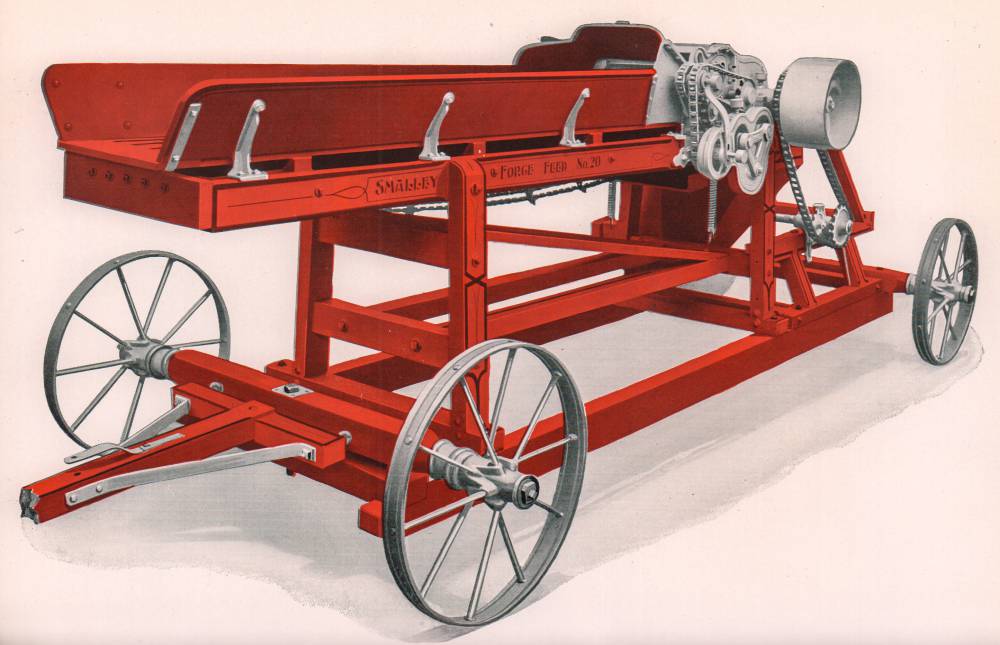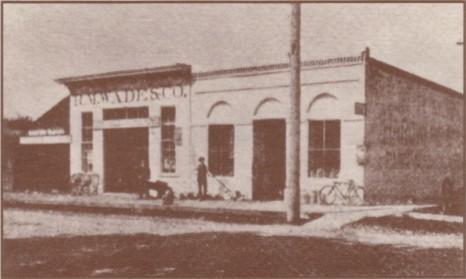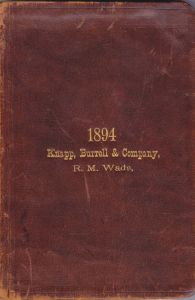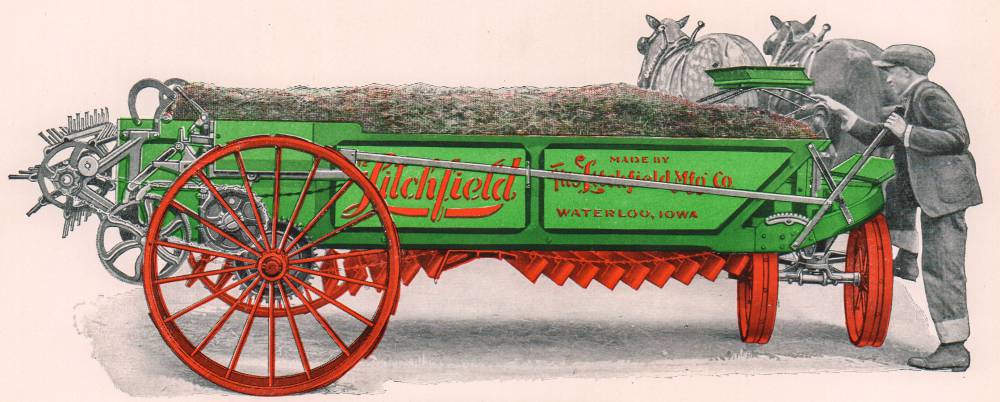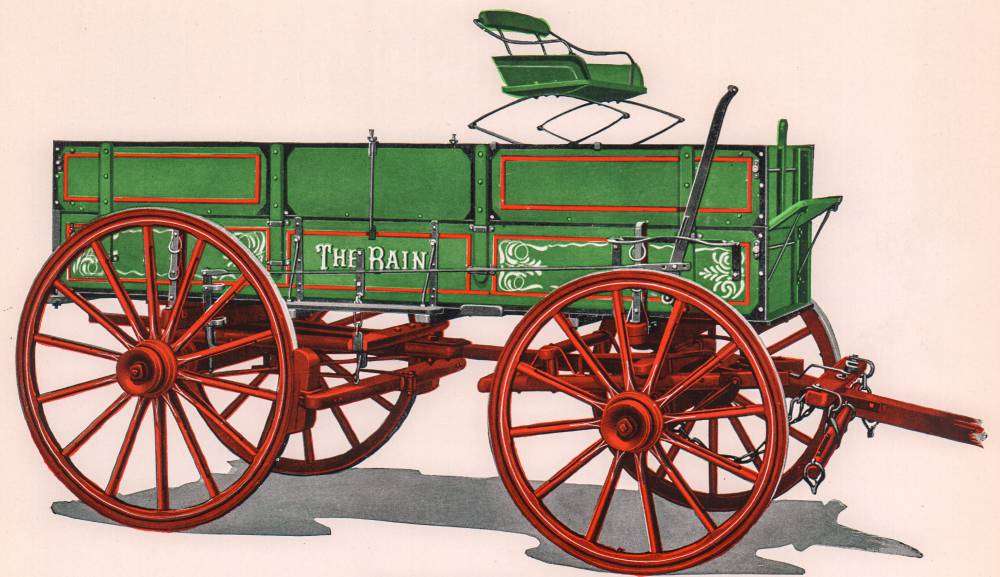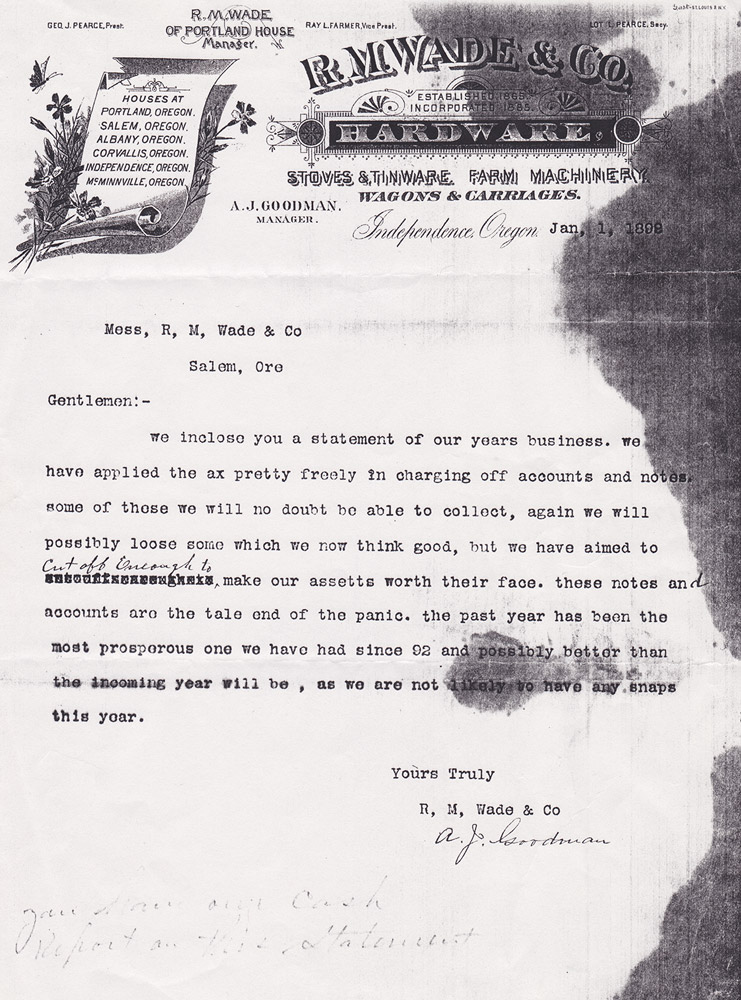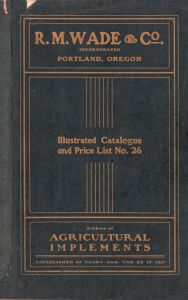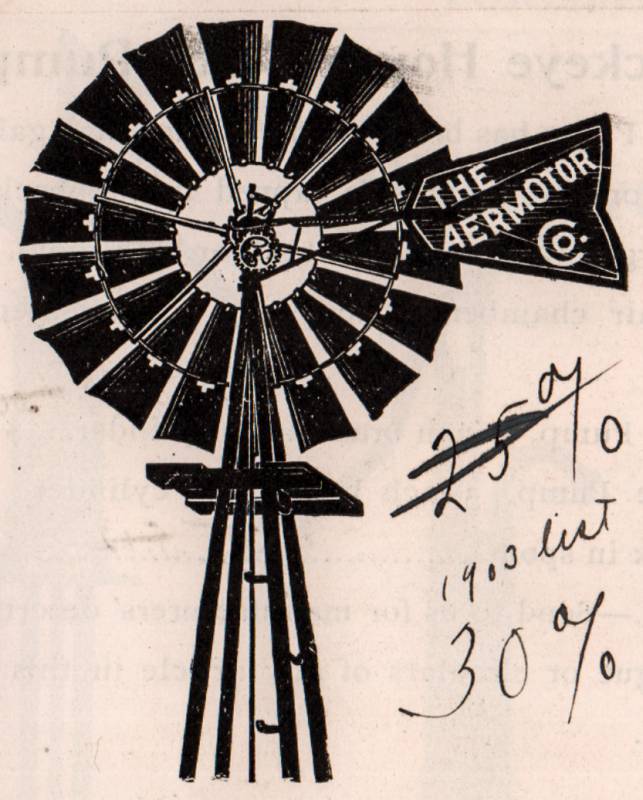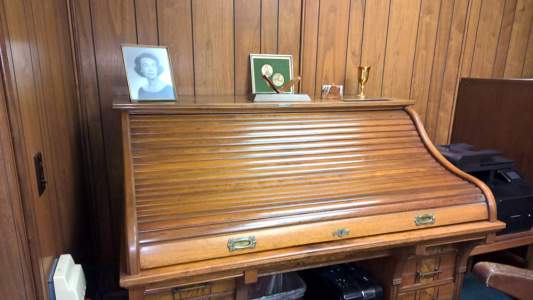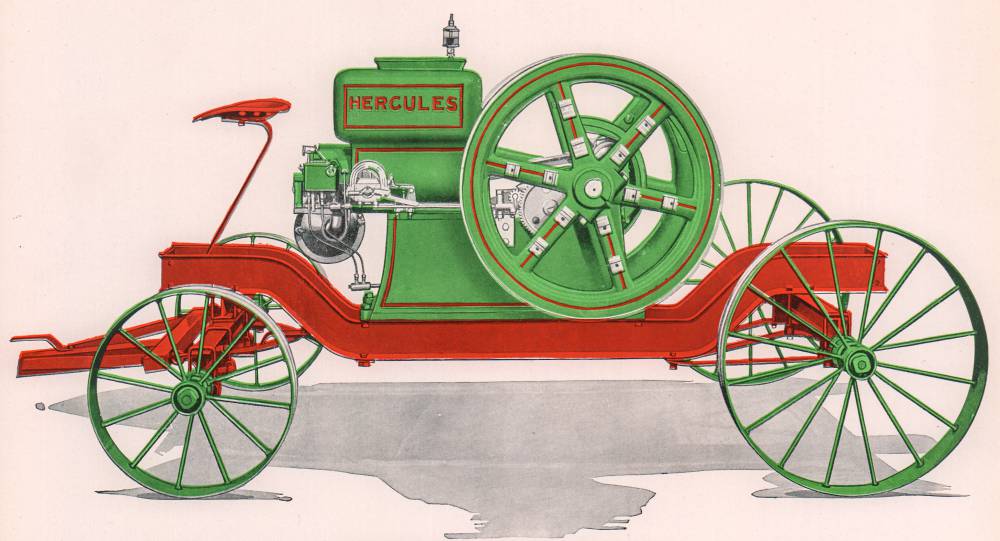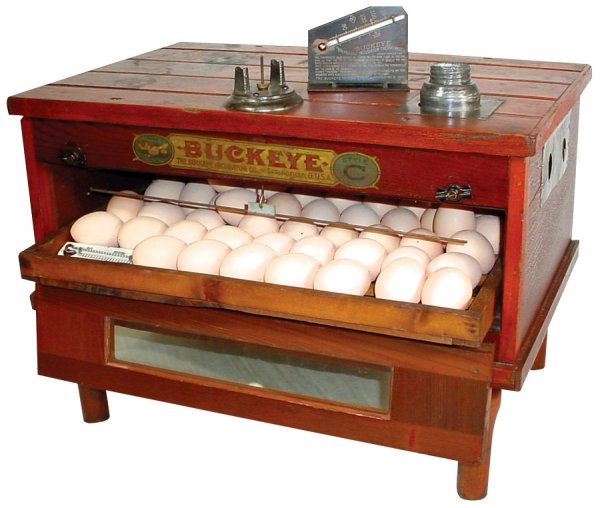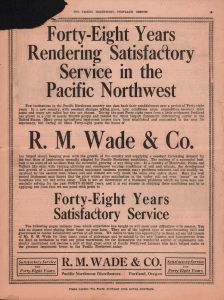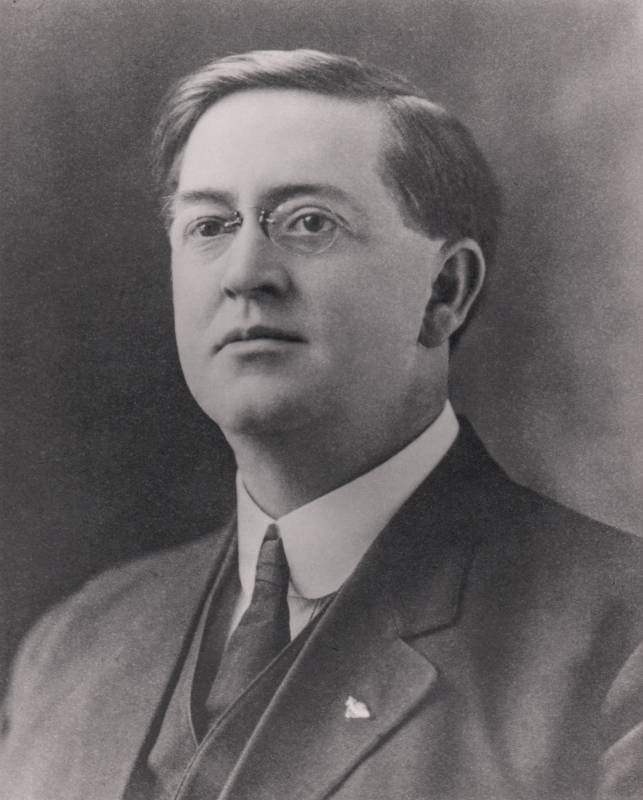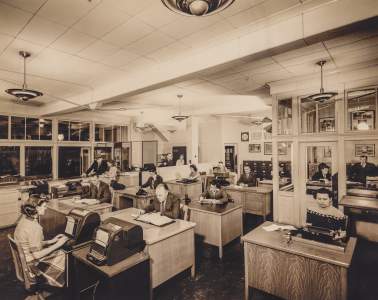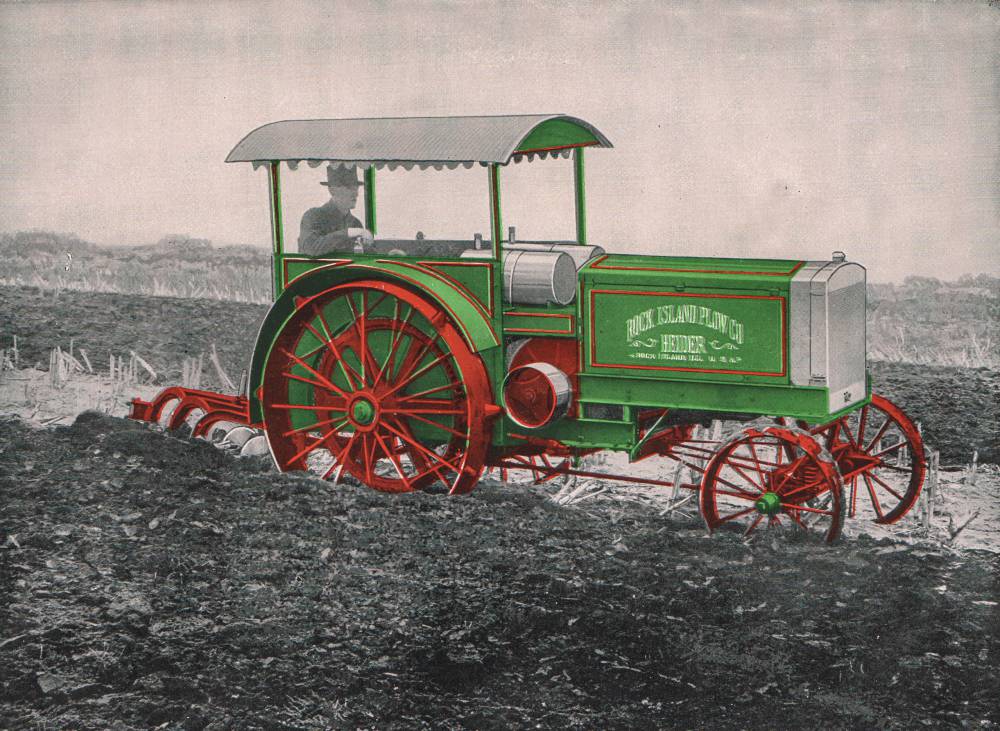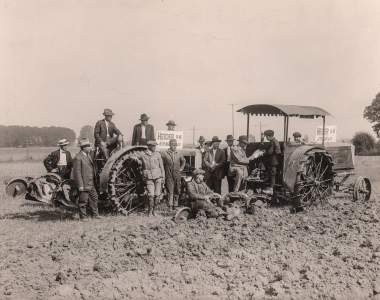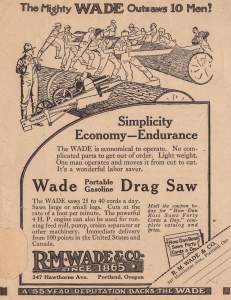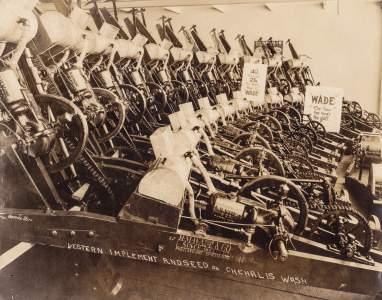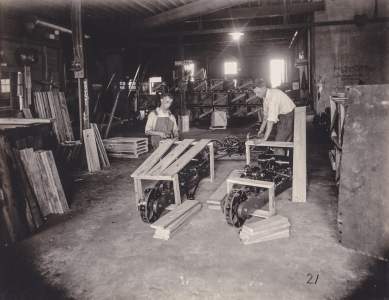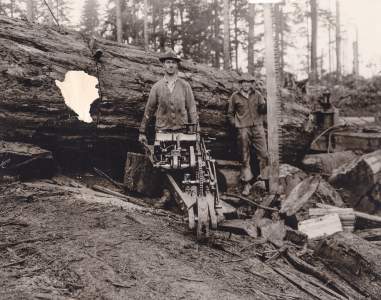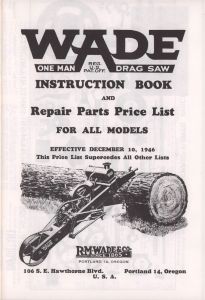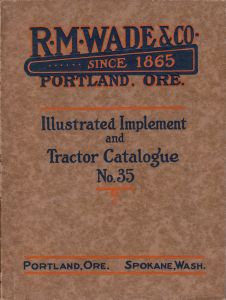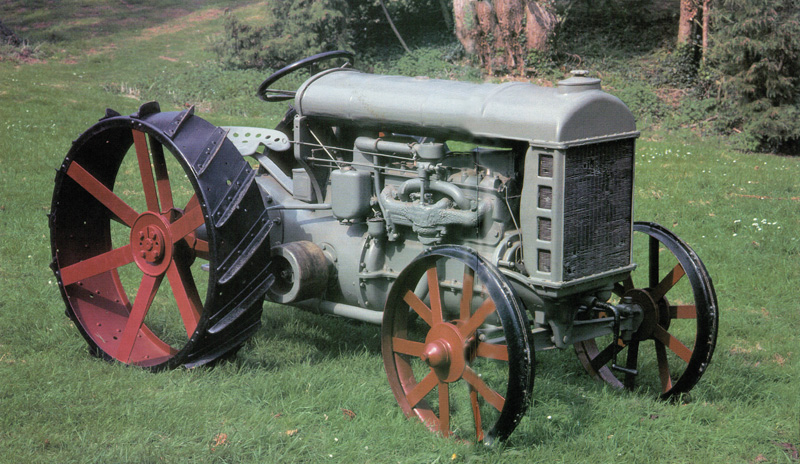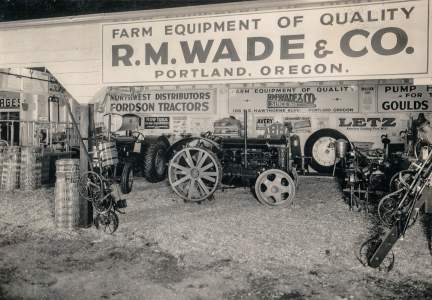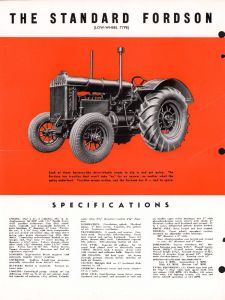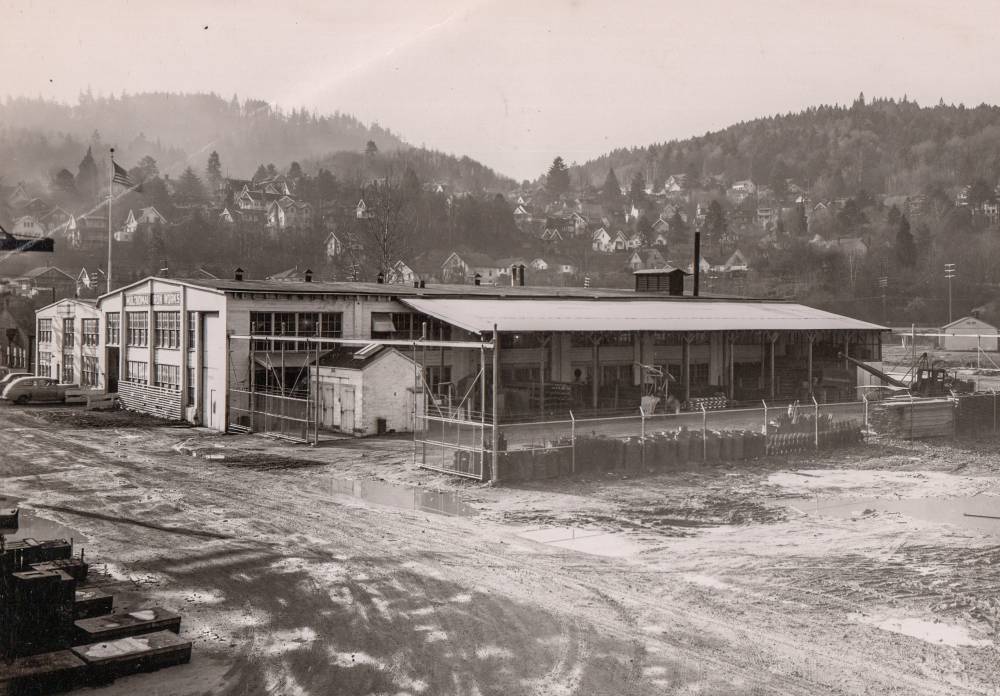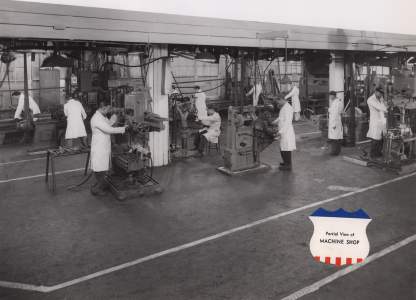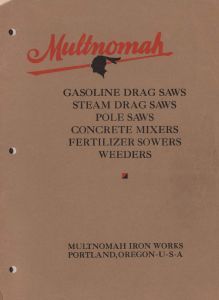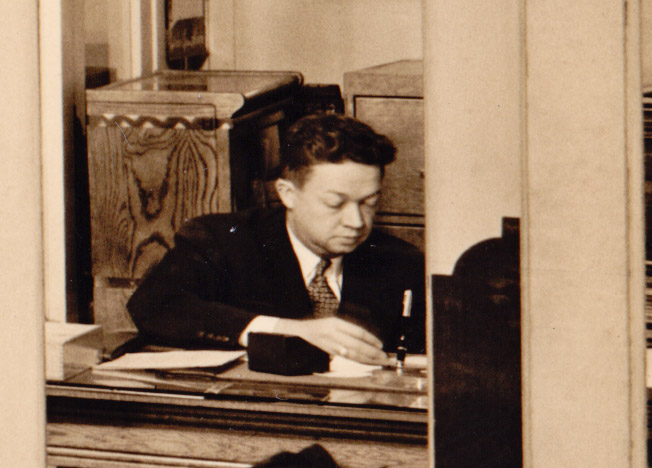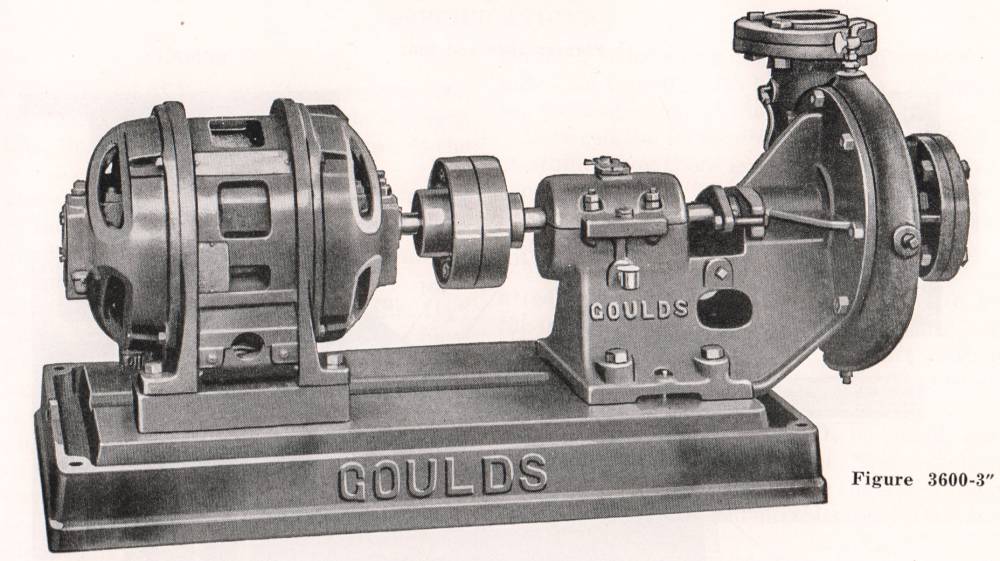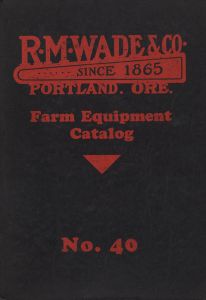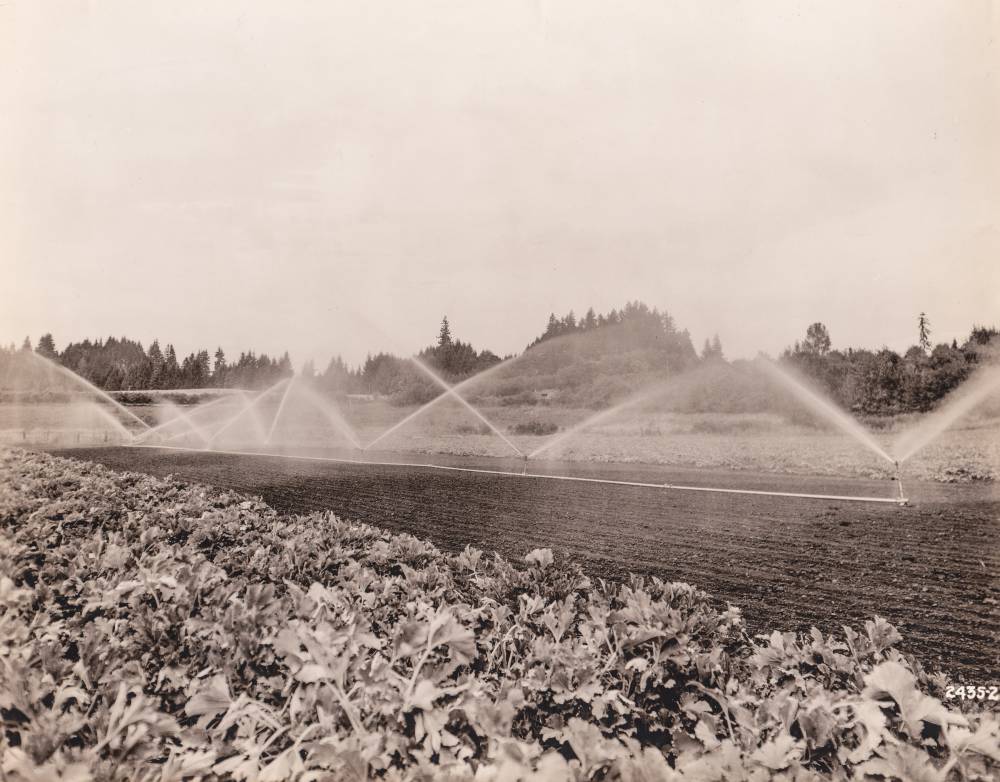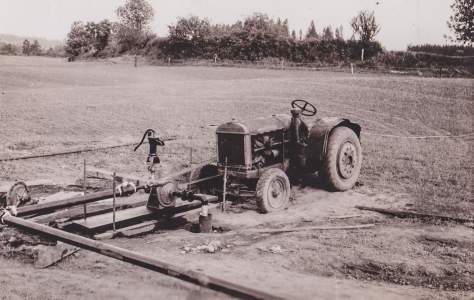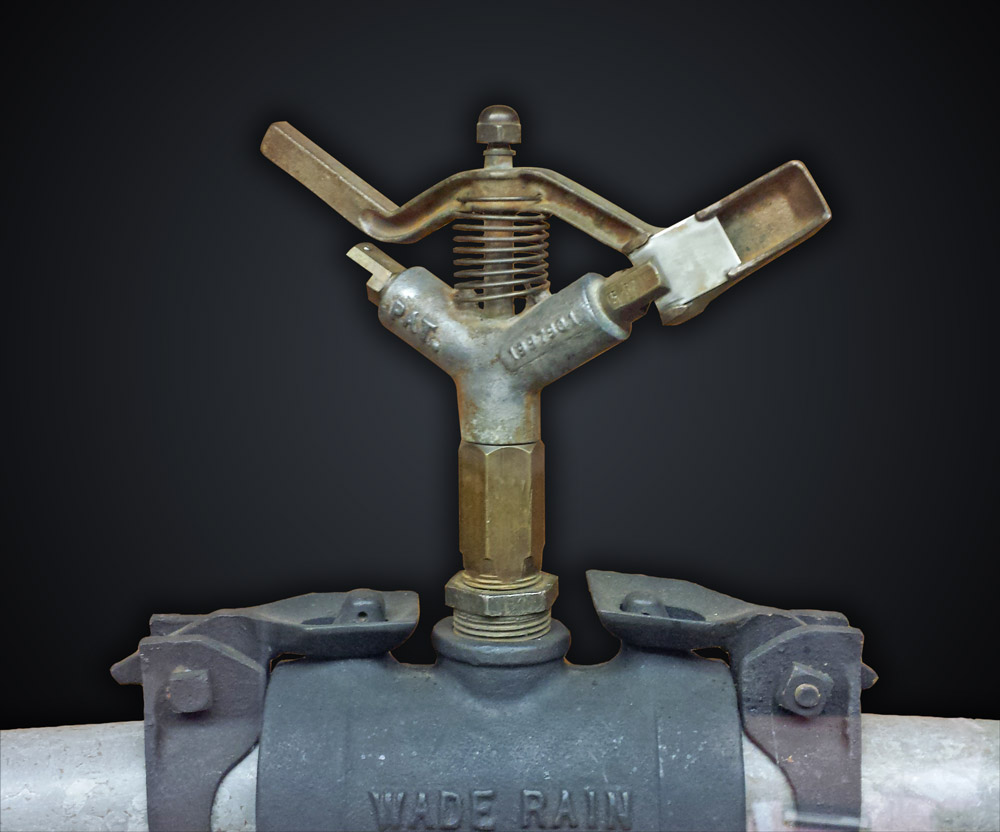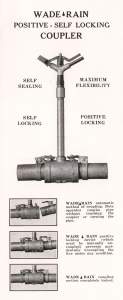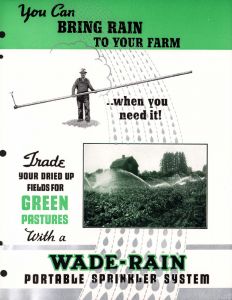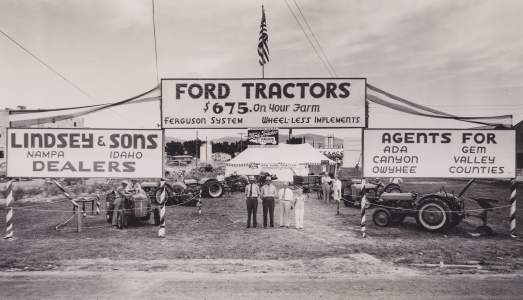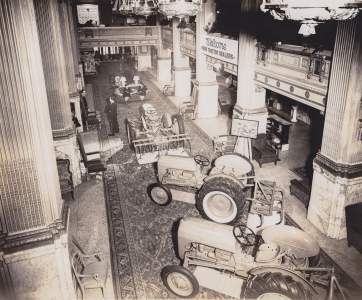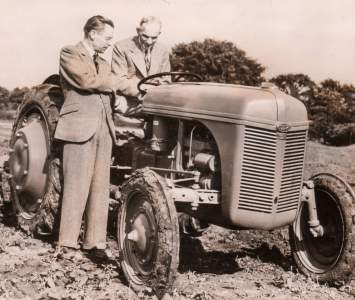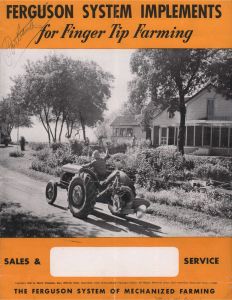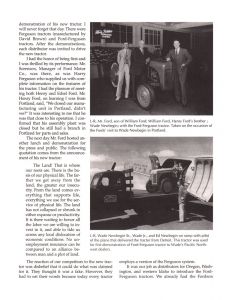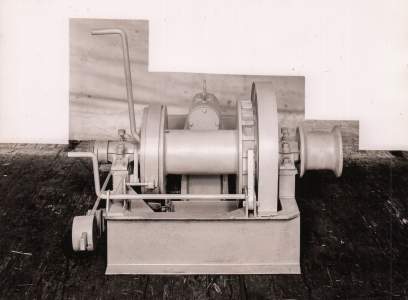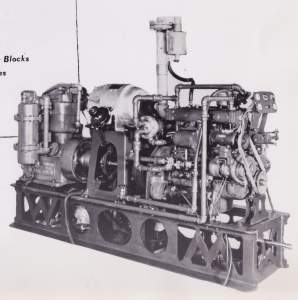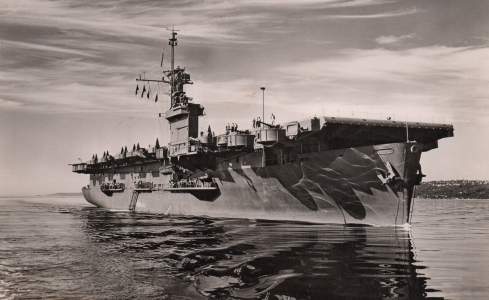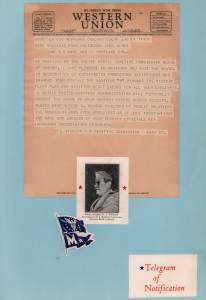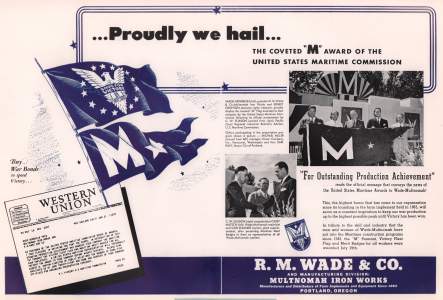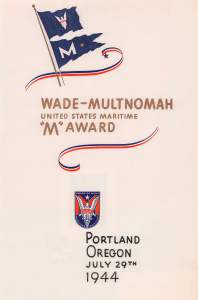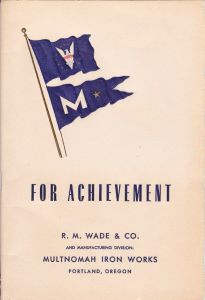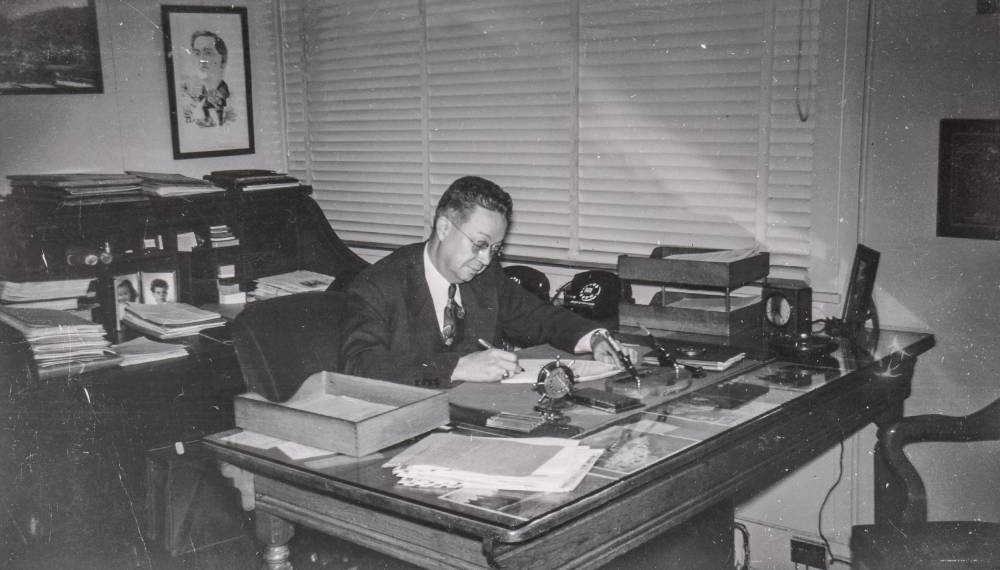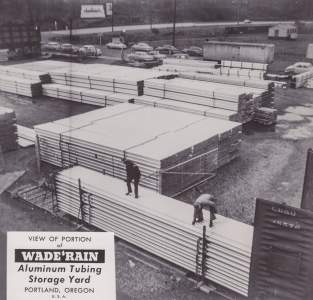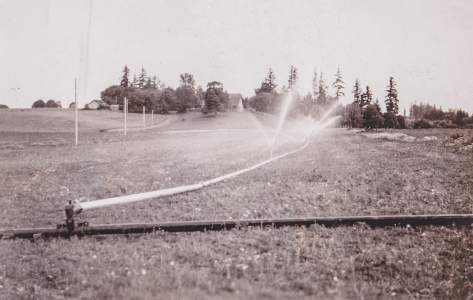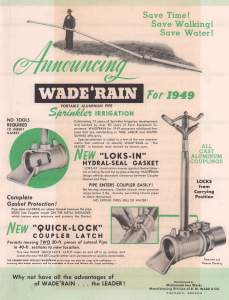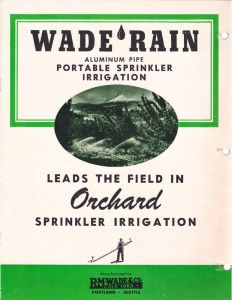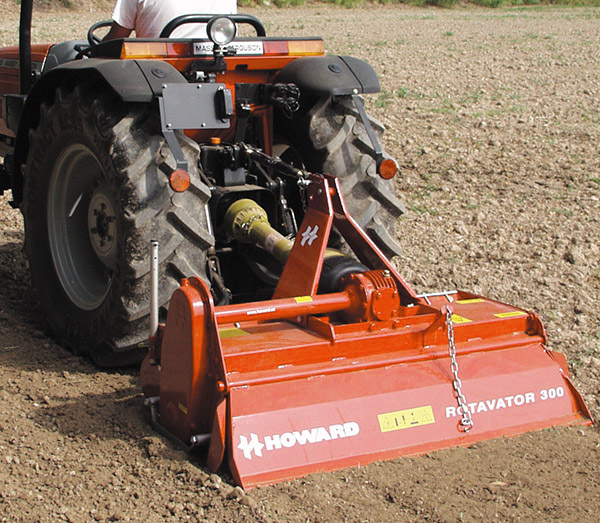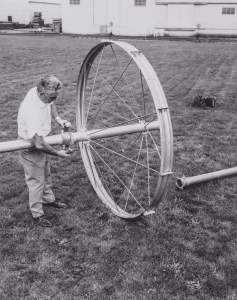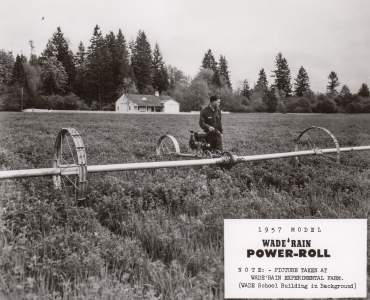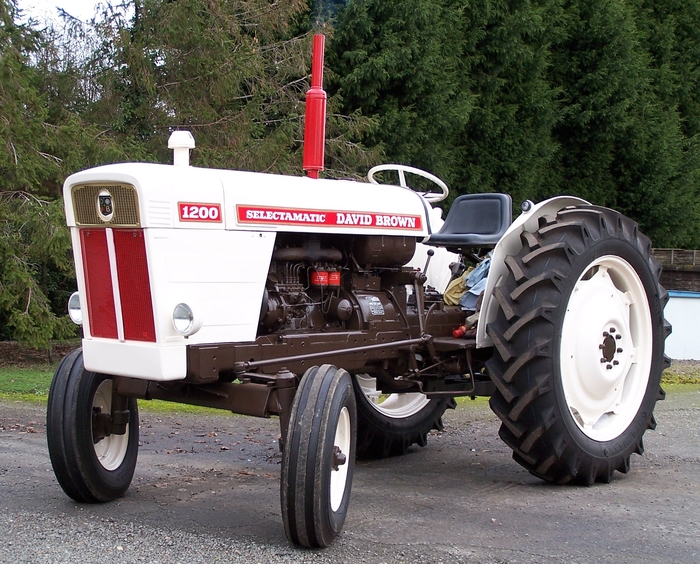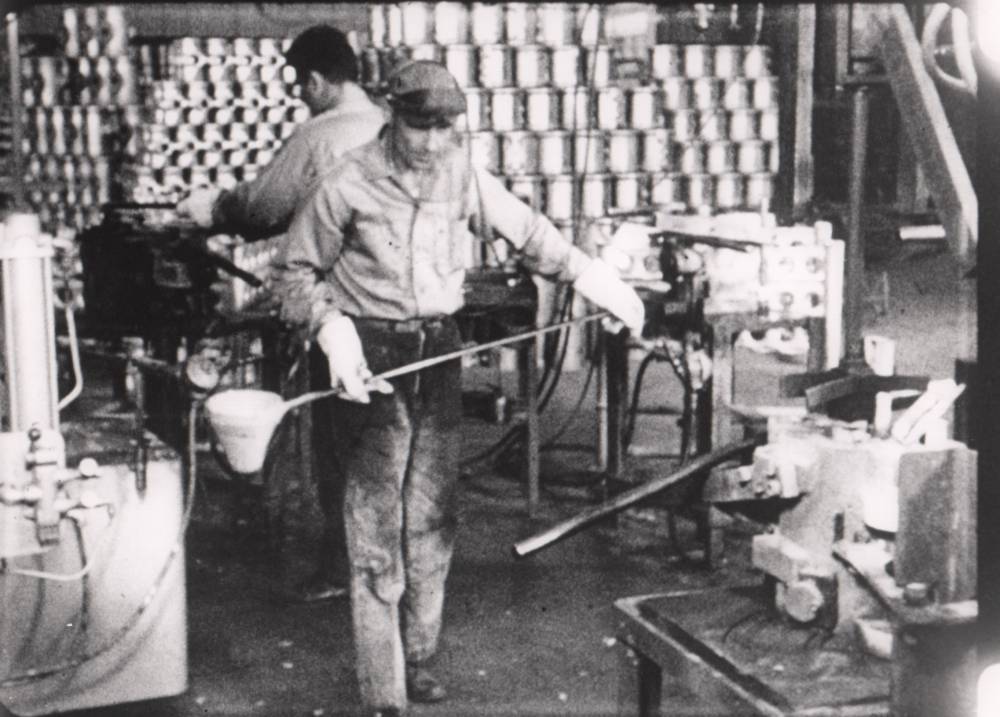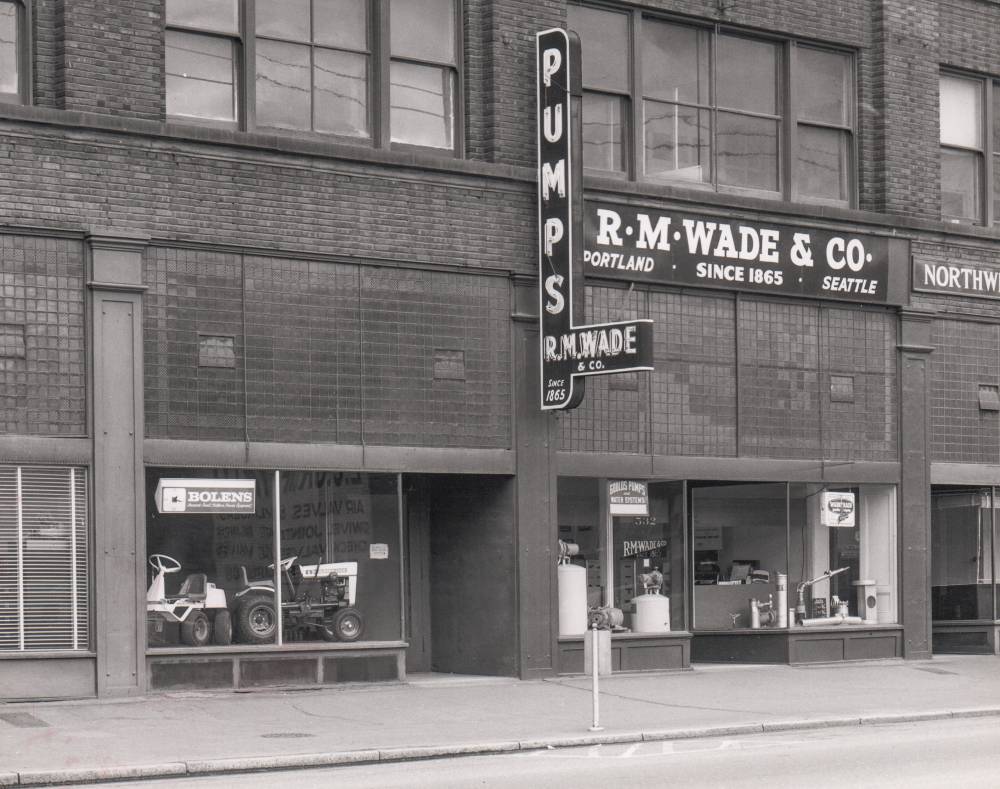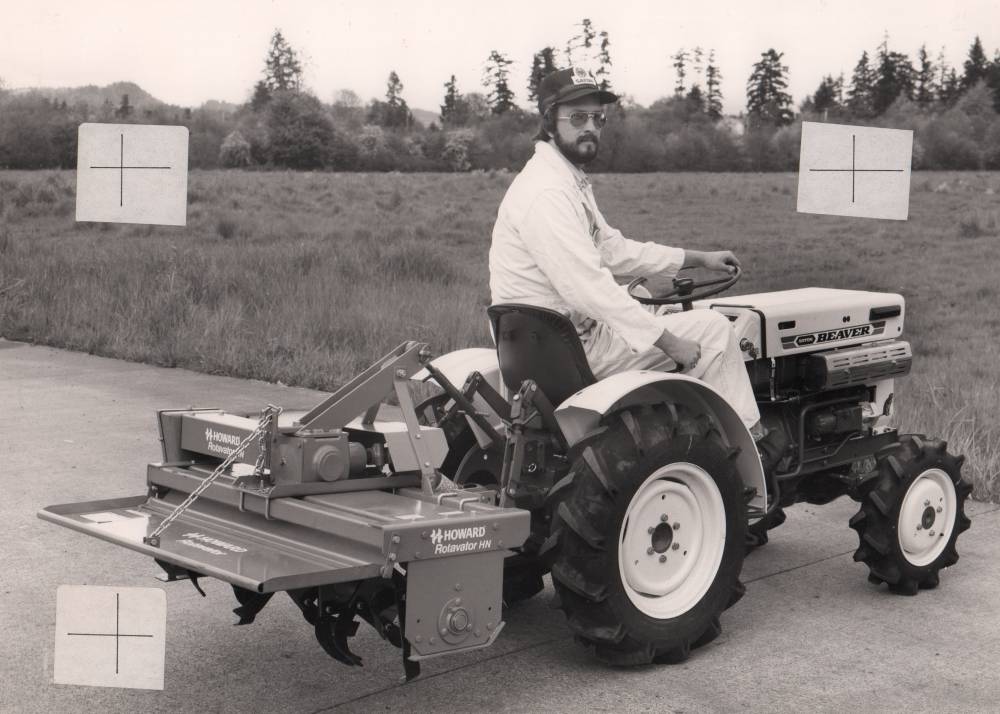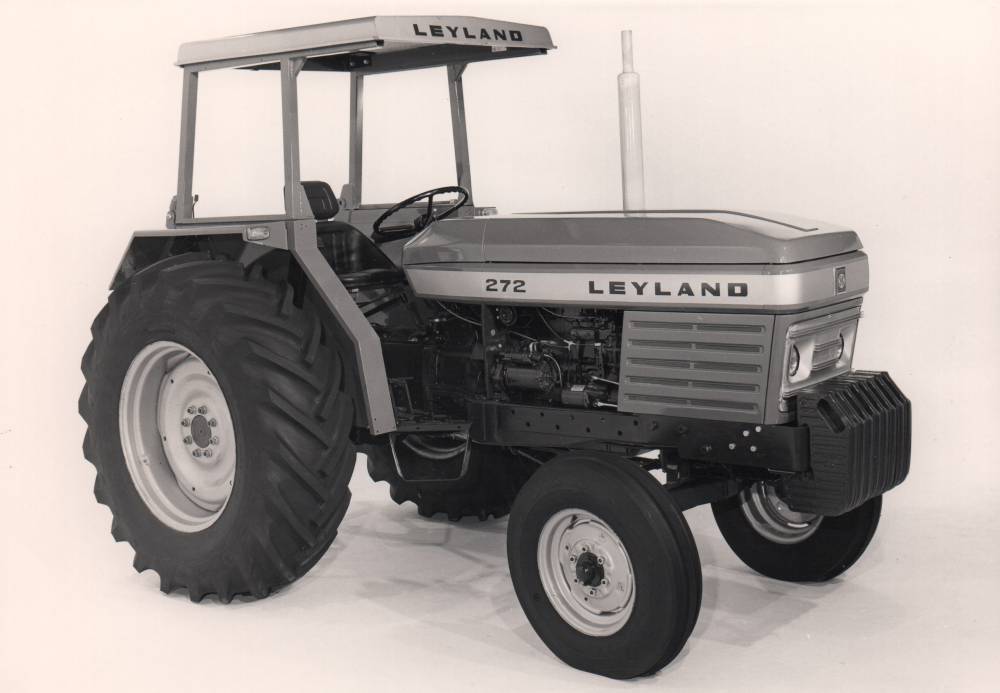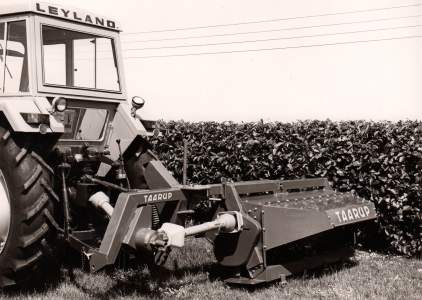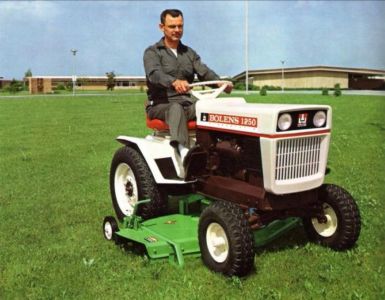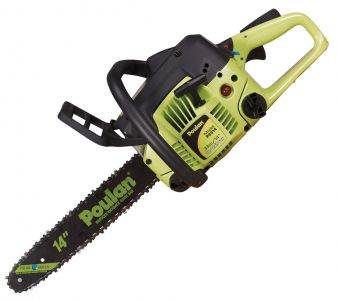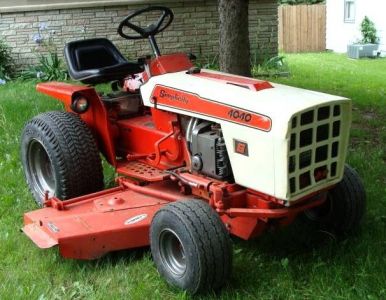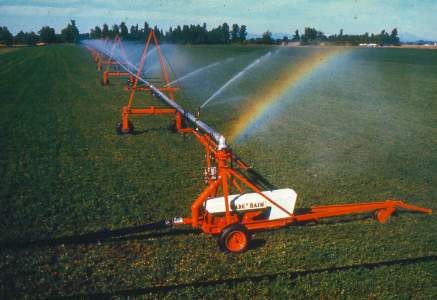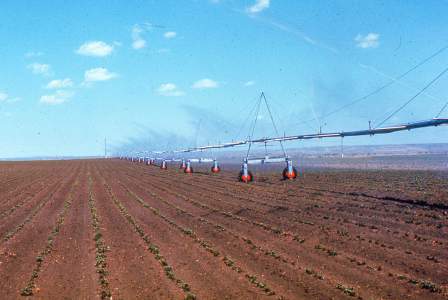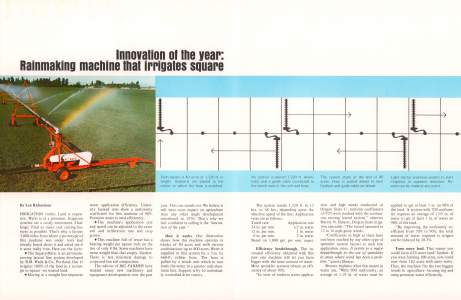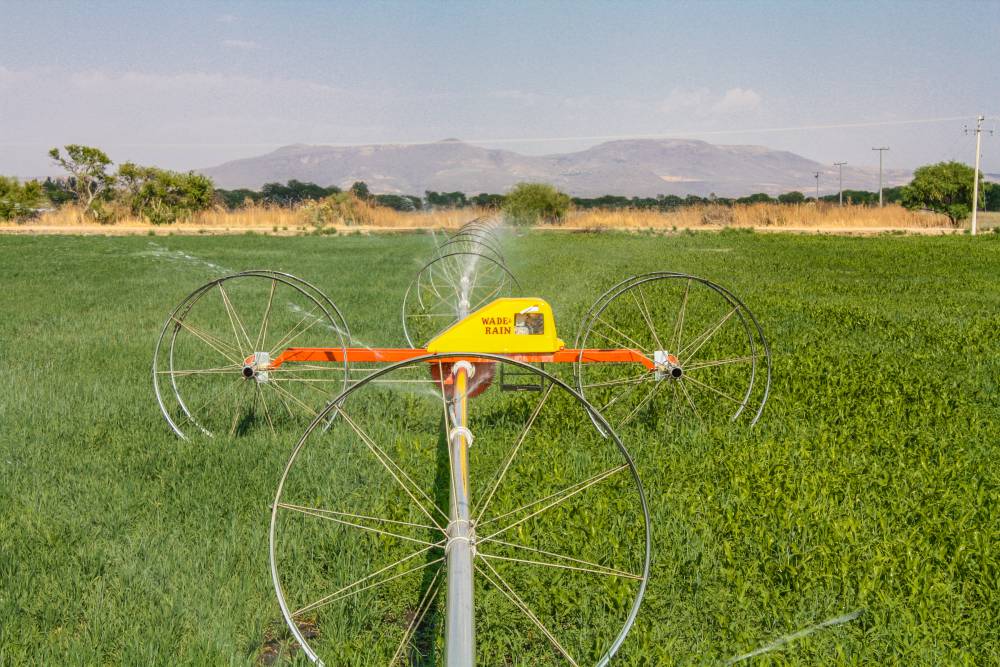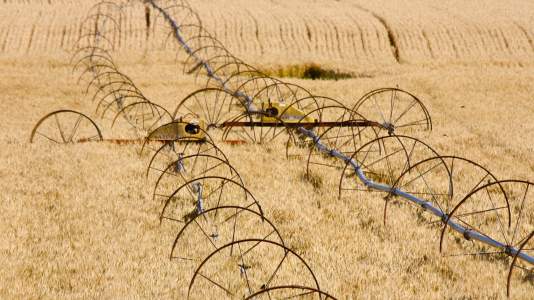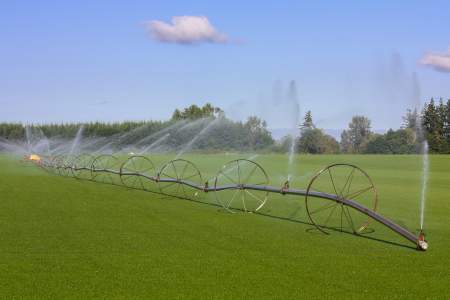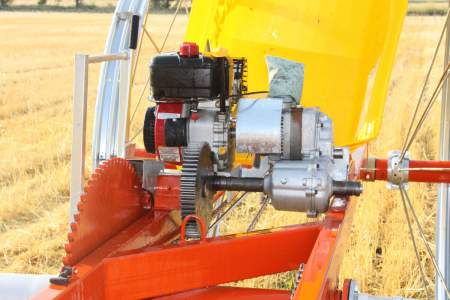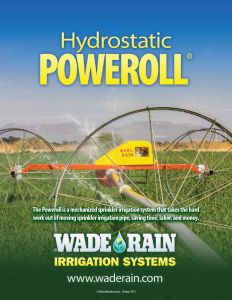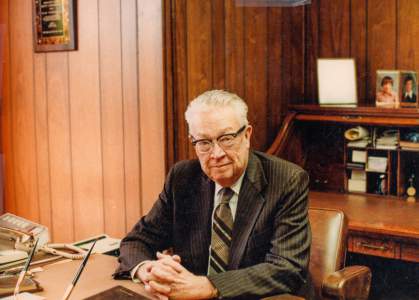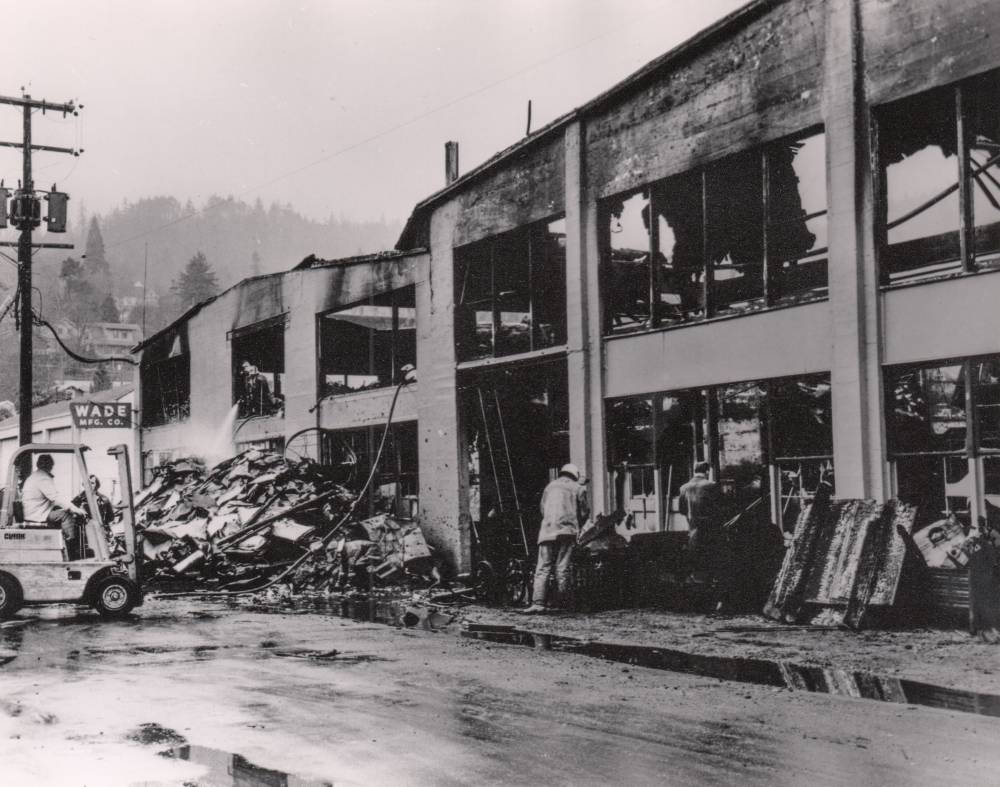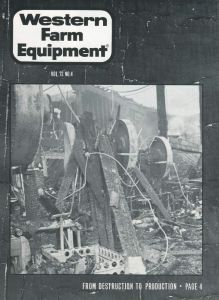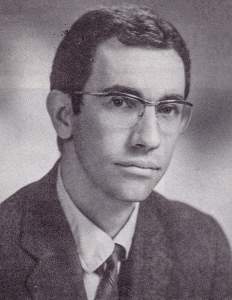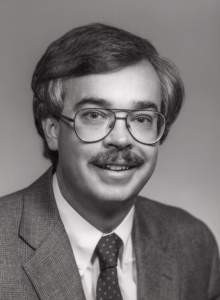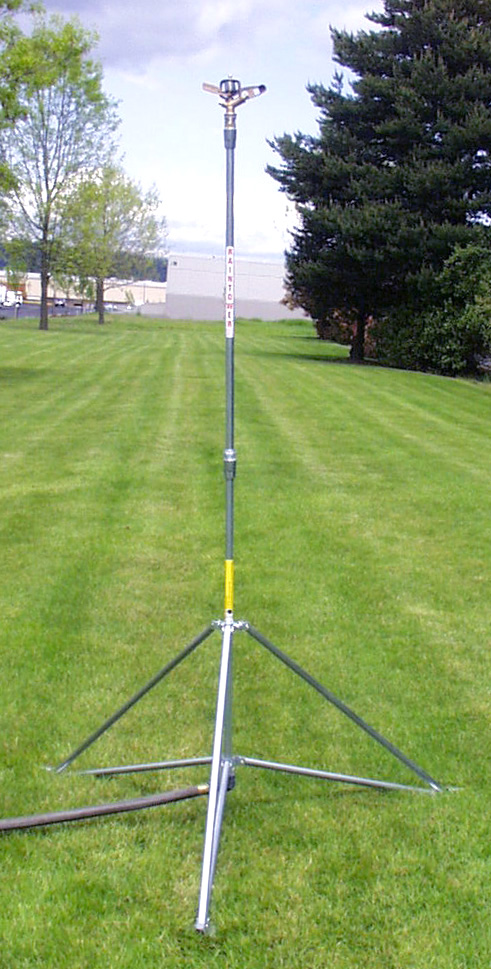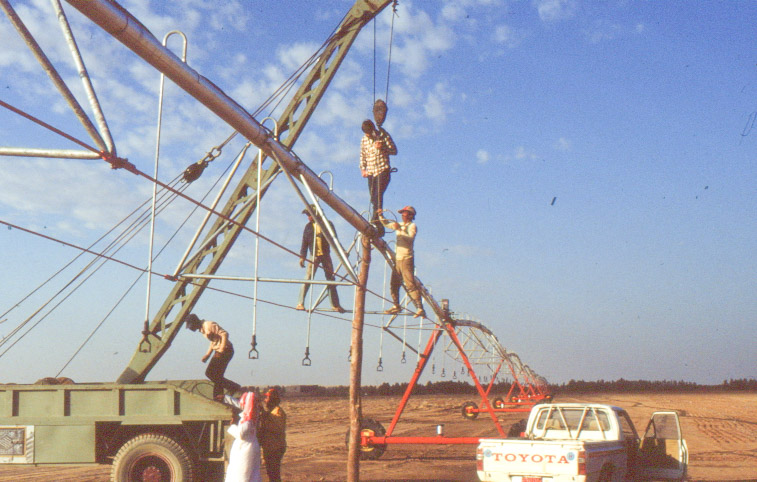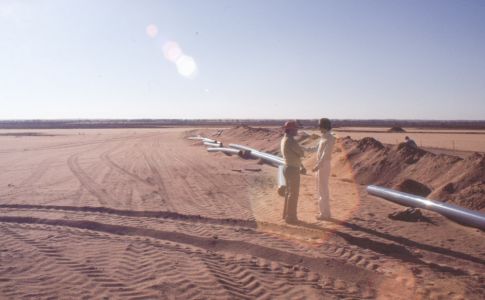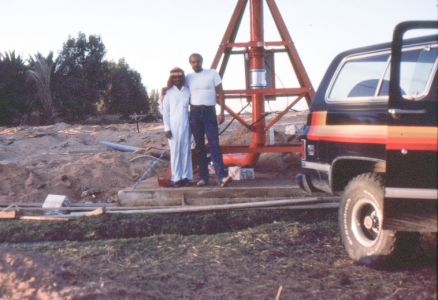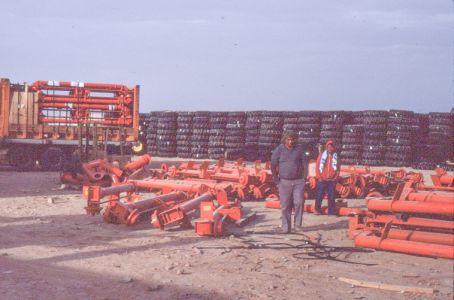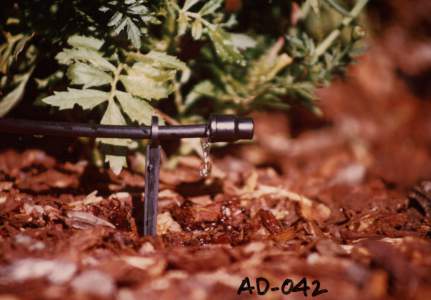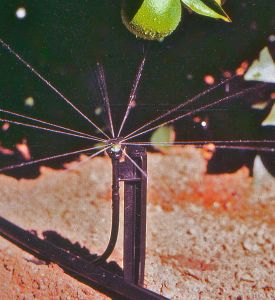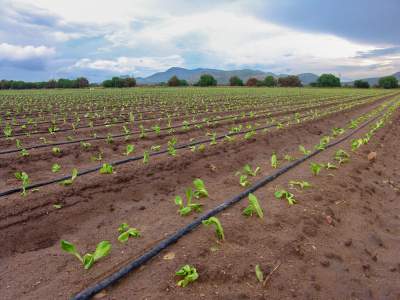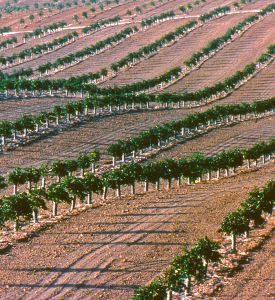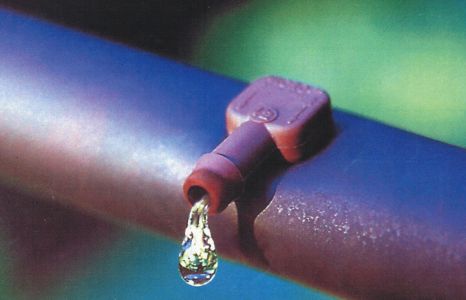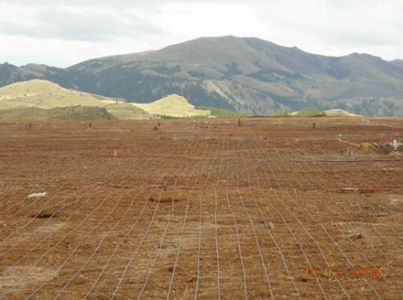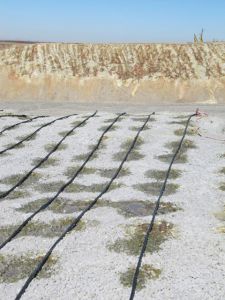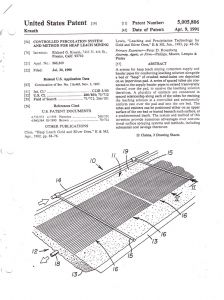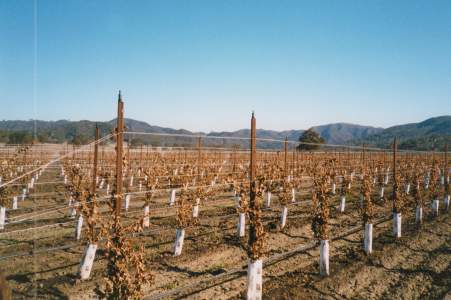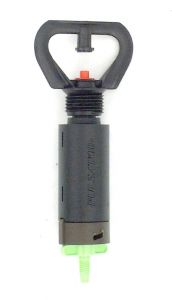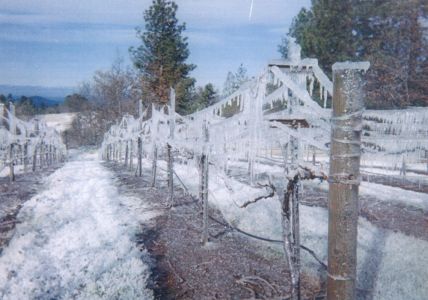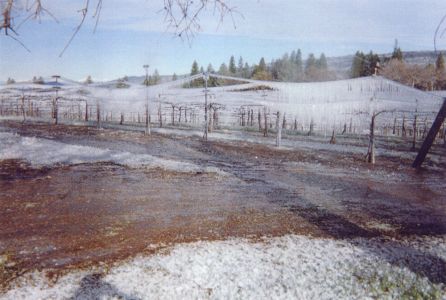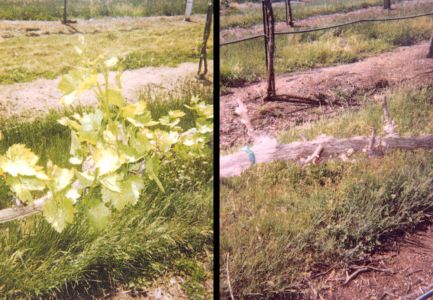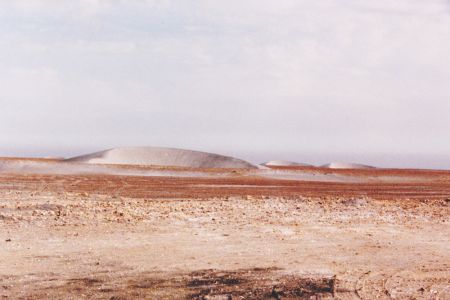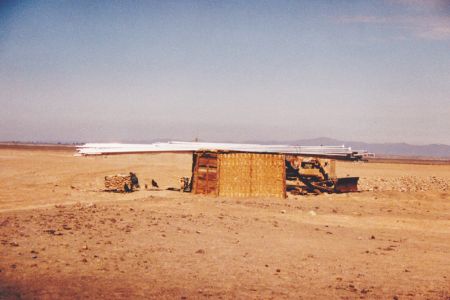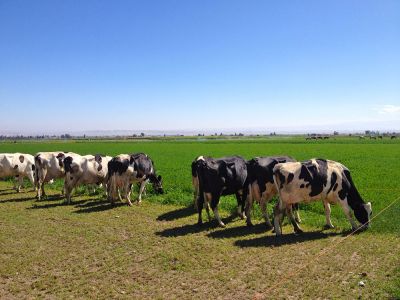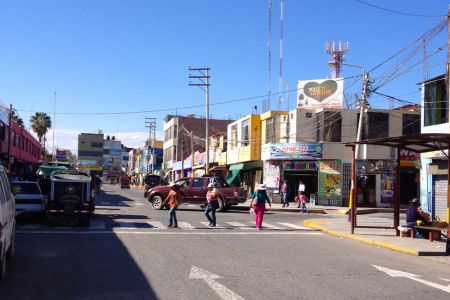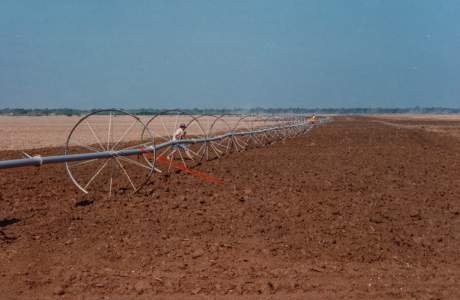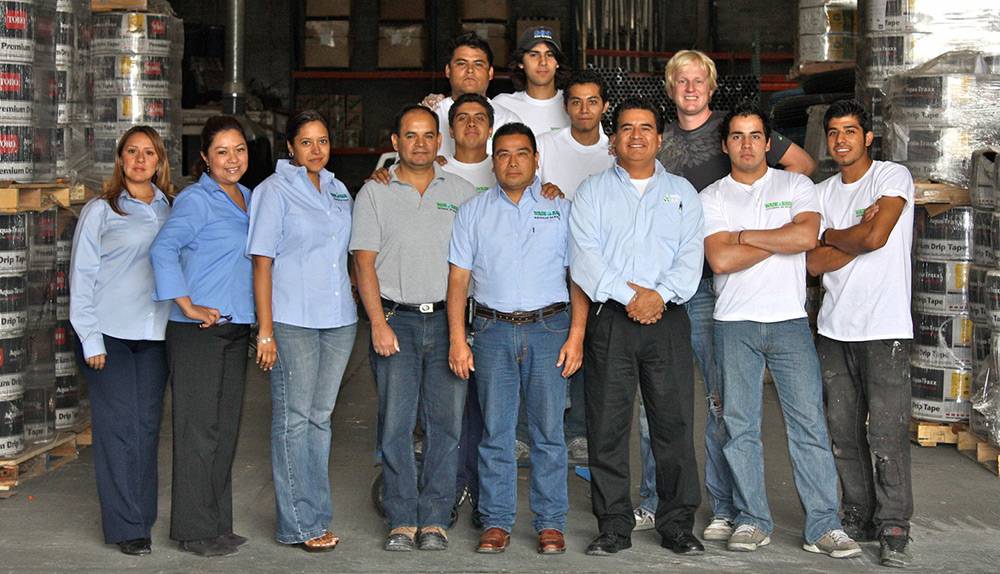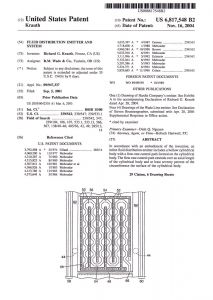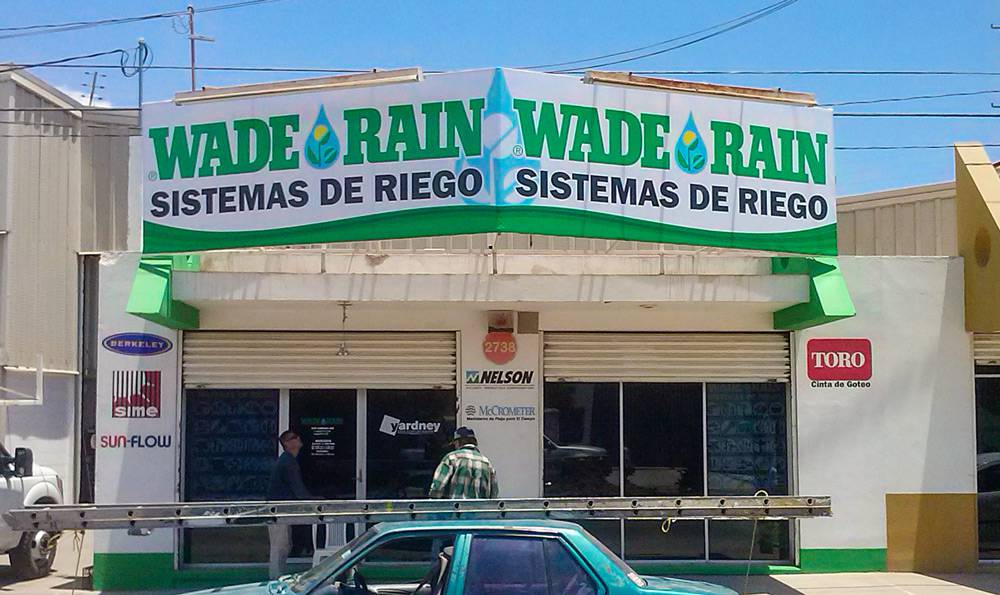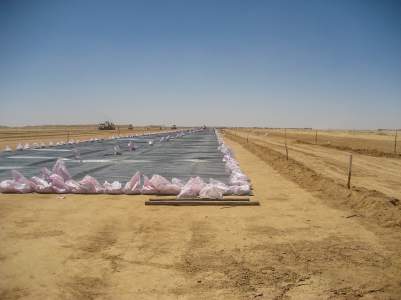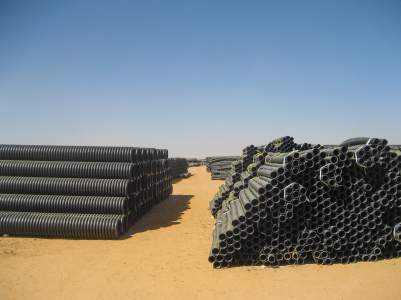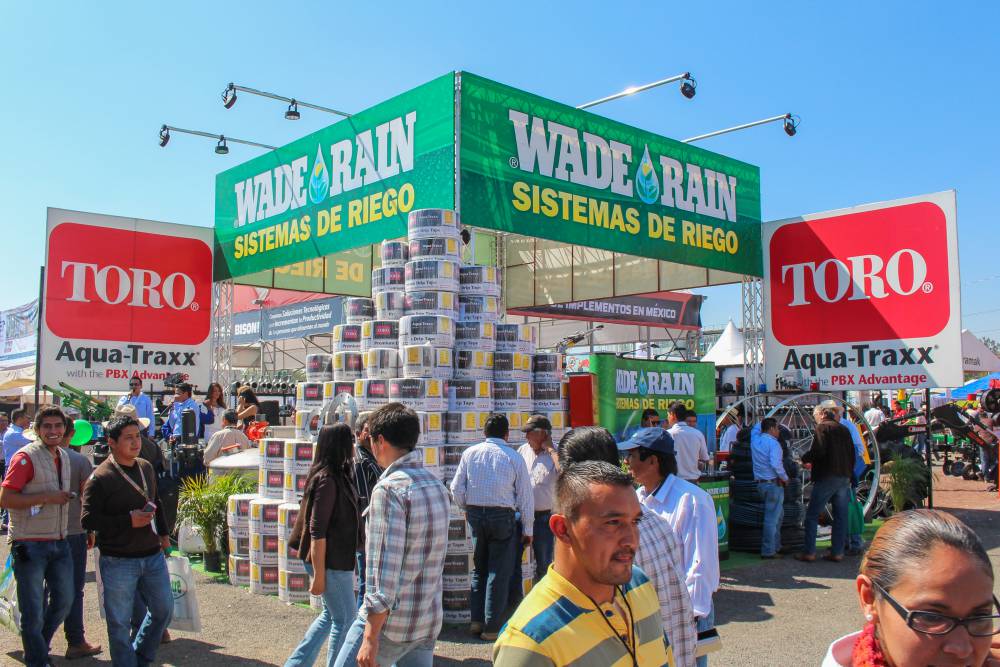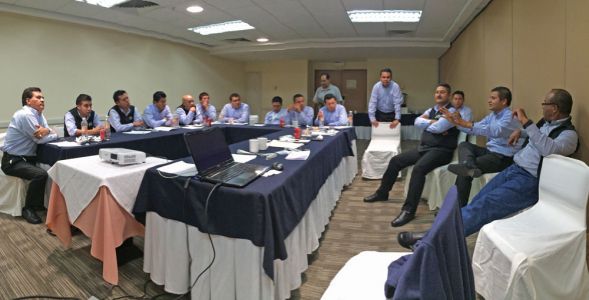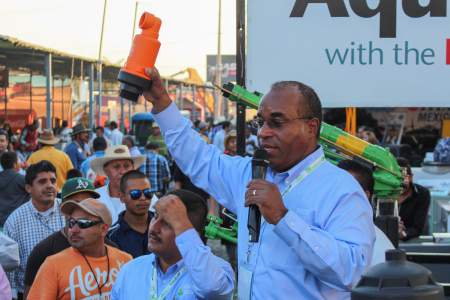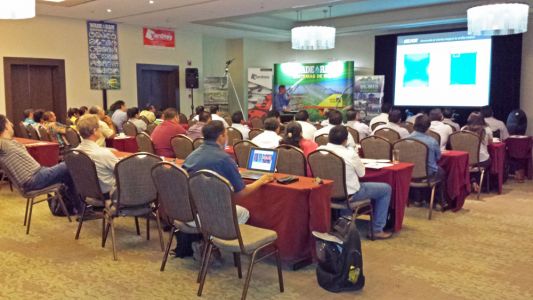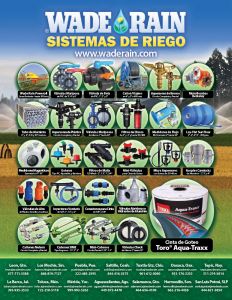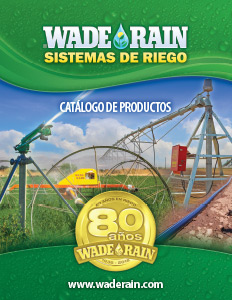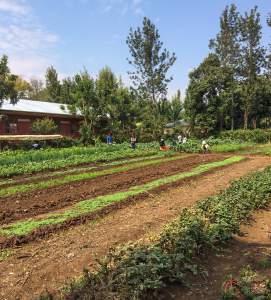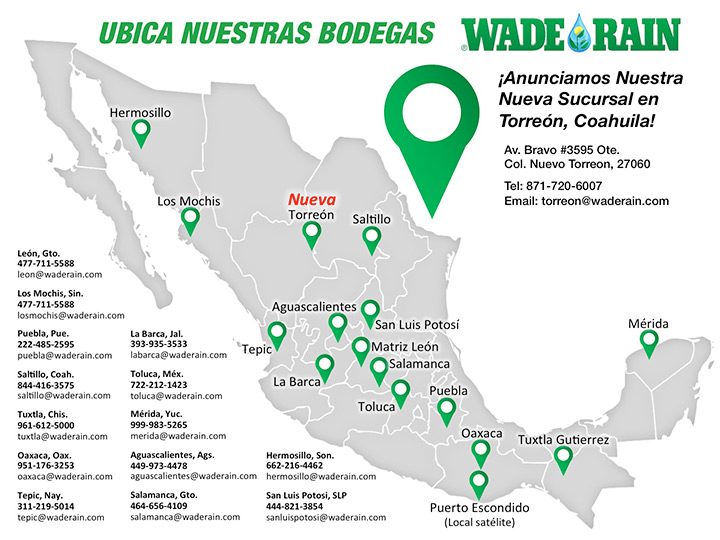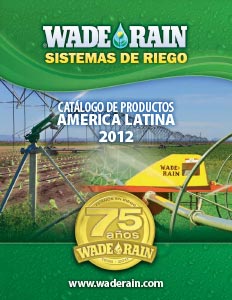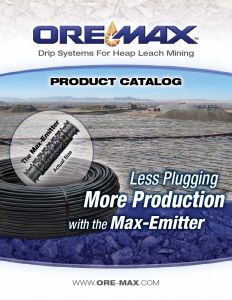1850
The Oregon Trail
Robert M. Wade (age 15) and his family crossed the Oregon Trail in 1850 and settled on a donation claim in Clackamas County near Estacada. He lived in Estacada for three years before leaving home.
The Oregon Trail migration, more correctly known as the Oregon-California Trail migration, is one of the most important events in American History. The Oregon-California trail was a 2,170 mile route, from Missouri to Oregon and California, that enabled the migration of the early pioneers to the western United States. The first emigrants to make the trip were Marcus and Narcissa Whitman, who traveled the trail in 1836. However, the first mass migration did not occur until 1843 when a group of approximately 1000 pioneers made the journey.
This trail was the only feasible land route to the West Coast. From 1843 until 1869, when the first transcontinental railroad was completed, over 500,000 people made the trip in covered wagons, which were pulled by mules and oxen. Some went to Oregon to farm and others went to California to search for gold. The trip usually took four to six months, traveling fifteen miles a day by wagon. The only other route to the West Coast was by sea around the horn of South America, taking a full year.
"Crossing The Plains" by Robert M. Wade
Robert M. Wade wrote a poem in 1897 called "Crossing the Plains" that described his experiences on the Oregon Trail as a young man in 1850. The original copy of the poem is below with a "translation" for easier reading.
"Crossing the Plains"
June 1, 1897
By R.M. Wade
This meeting of Oregon Pioneers
Calls to fading memory now
After forty and seven fleeting years
Our plans to raise wherewith and how
For leaving the grand old Missouri State
And for crossing the mighty plains
By the way of South Pass and Barlows gate
With some big cow and oxen trains
How father’s old wooden mould boarded plows
And mothers live wheels and her loom
Were traded off for a yoke of black cows
For which in our team there was room
A little money too we obtained
For our improvements on some land
And every available resource strained
The needed outfits to command
Poor people, tis some, have very poor ways
Some where you have heard or read it
No doubt the author of it lived those days
And just feels it when he said it
But people have always found a sure way
By hard work and push and hustle
And the means were ours on one happy day
To begin the westward tussle
Two yokes of five cows and four yokes of steers
And two wagons stoutly covered
Two big buckskin whips to awaken fears
Should laziness be discovered
Provisions, medicines of staple kinds
Guns pistols and ammunition
Most essential things the Pioneer finds
For an injun peace commission
Yes happy were we on that starting day
And our train a “thing of beauty”
Where we popped our whips and rolled away
With a mission and a duty
If you should believe the poor patient steers
Are dull and ignorant cattle
Observe the emotion that in them stirs
When they hear the ox yoke rattle
And when the dread yoke the neck has pressed
And the bows are through and keyed
Great sighs will convulse the ponderous chest
And deep sorrow is theirs indeed
But when the blistering buckskin cracker
Loudly proclaims its dreaded name
As when wielded by the expert “whacker”
Then they get there just the same
After we had crossed the great river leave
We headed westward and with the sun
With no count, no judge not taxes no law
Having no need for either one
Cholera was raging along the Plattes
Claiming its victims day by day
To bury in hasty graves on the flats
Grief shoots along the great “Hero Way”
Animals perished as well as men
Horses oxen and cows and mules
And wagons were often abandoned them
Along with harness yokes and tools
Relics of men the long road beside
Some portions into carts were made
Because the teams having got alkalied
Had died the sorry owners said
Necessity then drove us to invent
And some were forced to “foot it”
And to sleep in blankets without a tent
Or a beast on which to put it
Some begged to work their passage across
A charity called labors
Their worldly all being a total loss
And all pioneers were neighbors
Midst the howling of wolves night –serenaders
Had thunder storms and hurricanes
Had the red mans presence savage raiders
Seeking scalps and stampeding trains
We steadily measured step by step
The great Missouri valleys length
And across the grand Rocky Mountains crept
With bracing hope but waning strength
Then o’er Green Rivers desolate waste
We ( ?) fork and across to Snake
Awful slowly making haste no haste
Or hustle like jaded cattle make
We passed the cyclones breeding ground
And our mightiest rivers heads
Among the snow peaks stationed around
Upon the “Rockies” water sheds
We found many clean springs both hot and cold
Close beside each other flowing
And passed rich fields of silver and gold
Their whereabouts never knowing
We saw the Injuns Blackfeet Crows and Sioux
Who made their grave yards up in trees
Also wandering Flatheads (?) very few
And the snakes and the Shoshones
The latter were a degenerate lot
Clad in sun tanned injun hides
Many other garments they all had not
Than nature to all men provides
Some aristocrats wore a twisted string
Jauntily tied around the waist
With a napkin under with downward swing
Then up behind, attractive, chaste
Across this napkin each was a straddle
One end in front and the other behind
When on horseback it was a saddle
Of which they had no other kind
We passed them by without any muss
To boast of and be repented (?)
And our own fears of them and theirs of us
Some great fights no doubt prevented
On down along Snake River we crawled
Through hot sand and desolation
Doubling up our teams when one got stalled
On great mountain elevations
The sand and the dust and the alkalies
And the hot winds blistering heat
Mixed a burning moultan in our eyes
And went in with the food we ate
But when clean off of our good wagon sheet
The howling winds would lift the dust
Our stenciled boast our gaze would meet
“Bound for Oregon now or bust”
Then bye bye Snake River Burnt River too
Then Powder River and Grand Ronde
Thence on across the Blue Mountains blue
And the great Columbia was found
Yet onward and over the grand Cascades
T’was our last great spurt and rally
By way of the wonderful Barlow grades
Into the Willamette Valley
You may boast to me of the banquet hall
And monarchs mad dissipations
Roast Canvass Back oysters Champagne and all
For the grandest of the nations
But give unto me for the stomach’s grief
See its wailing complaints to hush
That same kind of boiled potatoes and beef
At the Foster ranch in the brush
We rested and we feasted there one day
While sweet Oregon showers fell
And washed our alkali dust away
And absorbed our sage brush smell
Then all bright and new we all felt next day
With Oregon spread all around
Uncle Sam just giving the land away
And we just accepted the ground
Uncle Sam had hung out our “Old Glory”
With our eagle screaming on high
But now here ends my plains crossing story
And with my blessing now good bye!
1853
Yreka, California Store
When he was 18 years old, R.M. Wade left Estacada and moved to Yreka, California, where he established a tent store to sell supplies to the gold miners. One story of Mr. Wade's time in Yreka is that he would sell eggs to the miners for $1.00 each ($27.00 each in 2010 dollars) a very high price indeed, but the miners were wealthy from their lucrative claims in the Yreka area.
1858
R.M. Wade Marries Ann Howard Williams
September 19, 1858
On September 19, 1858 Robert M. Wade married Ann Howard Williams, who had come west in 1850 on the same wagon train as R.M. Wade. Her family had settled in Yamhill county. She moved to Yreka after the wedding and the story is that on the day she arrived, the townspeople were dragging the body of a horse thief up the main street of the town. This did not impress the new Mrs. Wade.
1859
Oregon Becomes a State
February 14, 1859
Oregon becomes the 33rd state to be admitted to the union.
1862
Store Opened in The Dalles
R. M. Wade opened a store in The Dalles that was similar to the tent store he had established previously in Yreka, California.
Letters from R.M. Wade to his wife Ann
The Dalles May 12, 1862
Dearest Ann,
I received yours of the 2nd instead of yesterday and was glad to hear that you were all well.
This leaves me quite well and getting along finally. I expect to start to Portland day after tomorrow for more goods. I have been enlarging my tent and will soon have a very respectable store.
You need not be uneasy about me and the tent arrangement on Grand Ronde either, its all a humbug about the massacre in Grand Ronde. It was gotten up by the Walla Walla and Lewiston folks to turn the Powder River prospectors back and bring them through those places and on to Salmon. They are afraid of the Grand Ronde route and of course are doing all they can to prevent prospectors from going there for fear they will find a route from Grand Ronde to Salmon and make it a rival road to the great injury of Walla Walla and Lewiston. A good many are returning from Powder River and pronouncing it a humbug. The fact is they have rushed up there into the snow and not being able to prospect the bars on account of high water nor the hills and ravines for snow and cold weather they have got out of grub and some of them are turning back but they all acknowledge that they could not prospect much of course one half of them will return without working much be the mines ever so rich.
If the Powder River mines turn out bad I don’t wish to go to Grand Ronde but I want to get a hold up here somewhere and I intend to stick to the tent and do the best I can until I see an opening and then I will take a good holt and hang on.
I hope you will keep up spirits and have confidence in my plans. I don’t know what better I can do than what I am doing until I get acquainted with the Portland merchants and see an opening to get a house to sell goods in or a partner.
I have had the horses out on the range until yesterday I let a Yreka man have them on the shares he got a load to Deschutes this morning of miners baggage and I think will be able to make them bring in something for us both.
Oscar Wirthersill and George are here they have a money bank in company with two Yreka Spaniards. I got them both a little down on me because I would not keep George at big wages and let Oscar lay around and eat apples and cheese and to drink cider. They don’t bother me much now as a change has taken place yet in anything here no news from yours __?__ or George. Hoping to hear from you every week I remain as ever your affectionate Husband.
R.M. Wade
May 15, 1862
P.S. I did not send this as will see as soon as I expected. I was waiting until I started to Portland. I am going tomorrow morning. I will take what money I have down with me and leave the tent and goods and 3 horses and a wagon here but I don’t suppose anything will happen to me any way.
The river here is getting pretty high some of our big merchants have been driven out of their stores by the water and are now stuck up on the bluff in tents no better off than me. I want to get as many goods up when possible before the big rise comes as I think the Dalles will all be washed away and the chance to make something will be pretty good.
Glorious news from the East – New Orleans taken and Yorktown abandoned by the rebels and followed by the Federals besides other important and successful advances into the southern states.
Write often and don’t let Walter forget me kiss the baby for me Poor little fellows I would give all I have made here if I could only have you and them here
Yours, Robert
The Dalles Mar 20th 1862
Dear Ann
We arrived at this place day before yesterday. Your pa & George have gone out home with the boy I will go out there tomorrow. I stopped in town last night expecting to sell my horse but I have not been able to do so yet – Great numbers of men are crowding up here every day and & the town is quite lively. I have been trying to get a partner today but have been unsuccessful. I believe it will be impossible to get into business in this place as the houses are all occupied and everyone who has goods here thinks he has the best thing on selling them for a good price. I shall wait a few days until the river is open up to Walla Walla & until the roads are in condition to team and then if I can’t sell my horse and wagon I will start a team on the portage from Dalles to Deschutes until the Indian troubles are settled. I think it safe to go to Grand Ronde. But it is impossible to tell what one will do here as all is excitement & confusion & a person liable to be led a different direction by some new discovery. Jeff & George will not start until the snow goes off a little more which is very plenty here and about a foot deep on eight-miles out (so they say) but the south sides of the hills are bare in some places. I think it is a month too soon to go to the mines & probably to go at anything else beyond this place. David & Peter have three hundred & forty head of cattle left. They have lost in about the same proportion that others have so I have been told. I will write again when I get out there. Kiss the children for me & believe me as ever your
Robert own
P.S. Tell Cochran I will see about his sheep when I go out in the country. The people are all crazy up here. They ask $200 for yoke for cattle & $200 each for little broke down mules and sixty to 125 for cayuses that can hardly stand alone but it is nothing more than I expected. Good horses are not much in demand but they will be high as soon as the roads are in condition for teaming.
R.M. W.
Write to Dalles
Wasco Co. Oregon
Auburn Store
R.M. Wade opened a store in Auburn, Oregon located in Baker County. The store was sold it in 1865 when he moved to Salem.
1865
R.M. Wade & Co. Founded in Salem, Oregon
R.M. Wade left The Dalles for Salem, Oregon, where he bought an interest in the company, Smith and Cartwright, subsequently known as Smith and Wade. Then he bought out his partner and changed the name to R.M. Wade and Co. Originally the store sold dry goods, clothing, groceries, hardware, farming supplies, and agricultural implements to farmers in the Salem area.
1867
Copies of Documents 1867-1874
Below is an invoice dated June 1, 1867 from R.M. Wade to the Oregon Stage Company, which was a well known stage line operating between Oregon and San Francisco, California. It is uncertain what was sold as the ink has faded, but this is a scan of the original invoice.
1870
First R.M. Wade Letterhead from Salem, Oregon
February 22, 1870
Below is a scanned copy of stationery with the first R.M. Wade letterhead from the Salem, Oregon location. In addition there is a purchase order that was issued to Henry Failing of the Corbett and Failing Company. Both Corbett and Failing were prominent Oregon businessmen at the time and co-founders of the First National Bank of Oregon in 1856.
McCormick Reaper
The McCormick Reaper, a new wheat harvesting machine, was distributed by R.M.Wade. It was invented in 1837 by Cyrus McCormick and it was an entirely new concept in harvesting grains. For thousands of years farmers had been using the hand scythe to cut and bundle grain during harvest. McCormick invented a machine with a reciprocating cutter bar with knife like teeth, which cut the grain. Then a reel would load the grain on a platform. The R.M.Wade Company began selling the McCormick reaper in the late 19th century and it revolutionized harvesting methods in the Northwest.
1871
Telegram to Henry Failing
September 14, 1871
This is another order to the Henry Failing Company which is for 4 kegs of blasting powder and they seemed to be in a hurry to get it.
Treadmill Thresher
The treadmill thresher was a two horse powered threshing machine, which separated the wheat from the straw in an automated way. This machine replaced hand threshing, which had been the only way to separate wheat from straw for thousands of years.
1872
Modoc Wars
1872-1873
During 1872-73 the wars between the U.S. government and the Modoc Indian Tribe took place in Southern Oregon in the Klamath Falls area. Captain Jack the leader of the Modocs was very successful in fighting against a superior force and the war went on for many years.
Oliver Chilled Plow
The R.M. Wade Company distributed the Oliver Chilled Plow from approximately 1875 until 1920. It was invented in 1858 by James Oliver in Elkhart, Indiana. Oliver sold fifty plows his very first year in business. By 1860 he had perfected the product and introduced the famous Number 40. The new plow used a patented manufacturing process of chilling the steel such that the outside cutting edge remained hardened and sharp for easier plowing of the soil. In addition, the face of the plow was softer and smoother, so that the farmer didn't have to stop and clean it as often as earlier plows. By 1878 Oliver was selling 300,000 plows a year, which was an unprecedented number. Unfortunately, he refused to make a plow which could be ridden by the farmer. As a result he lost a lot of the market to the John Deere Company, which manufactured a riding plow. The Oliver Company remained independent and eventually evolved into the Oliver Tractor Company.
1875
R.M. Wade Letterhead
October 4, 1875
This letterhead from 1875 shows pictures of a McCormick Reaper on the left top and probably a Bain Buckboard Wagon on the top right.
1880
Van Brunt Seeder
The Van Brunt Seeder was another popular product distributed by the R.M. Wade Company during the last half of the 19th century. Previously all seeding had been done manually. The seed was sown by scattering it over the field by hand, a very labor intensive process. In 1860 George Van Brundt invented a new mechanical seeder which planted seed seven rows at a time. It injected the seed far enough underground that birds couldn't eat the seed, something that had been an enormous problem from the origination of farming. The concepts employed in the Van Brunt seeder are still the basic design of all modern seeding machines. Another back breaking farm job had been made much easier and faster by the innovation of a new product.
Lightning Hay Press
The Lightning Hay Press was an early version of the hay baler. It was truly a one-horse-power machine driven by a horse turning a wheel to power the machine. There is very little information about the company that made the Lightning Hay Press, but it was widely used to bale hay.
1884
R.M. Wade Moves to Portland
R.M. Wade moved the business to Portland. He purchased a building on the East Side that occupied a full block on Hawthorne Avenue between 1st and 2nd Street.
1885
R.M. Wade & Co. Incorporated
R.M. Wade - Independence, Oregon
During the 1880's R. M. Wade established branches throughout the Willamette Valley. In addition to the main business in Portland, as well as the original store in Salem, there were branches in Independence, Corvallis, and Jacksonville.
1890
Smalley Alfalfa Cutter
1890-1915
Alfalfa cutters were commonly used to cut silage for dairy feed. The Smalley Cutter was one of the original types of alfalfa cutters.
1893
1894
Knapp, Burrell & Company, R.M. Wade & Co. Catalog
This is the earliest catalog that we have with R.M. Wade products in it. We think Knapp and Burrell was the agent for R.M. Wade but we are not sure. All we know is that these pages appeared in their catalog and eventually R.M. Wade acquired the Knapp and Burrell Company.
1895
Litchfield Manure Spreader
The R.M. Wade Company sold the Litchfield line of manure spreaders for many years. There was a humorous company slogan at the time saying:"We stand behind all of our products except the manure spreaders." The Litchfield company was founded in 1879 by Lyman Litchfield and was located in Waterloo, Iowa. By 1922 it employed 450 people and was the largest manufacturer of manure spreaders.
1896
The Bain Wagon
The R.M.Wade Company distributed Bain wagons for many years. It was its major line of farm wagons. Edward Bain, the founder of Bain Wagons, had moved to Kenosha, Wisconsin at the age of nineteen in 1852, and had purchased a hardware store. One of his customers, The Mitchell Wagon Works, couldn't pay its bill so Bain took over the company in exchange for the debt. Recognizing the potential of the wagon company, Bain closed the hardware store in order to focus on the wagon business, renaming it the Bain Wagon Works. By the year 1879 he was selling an incredible 10,000 wagons a year, and by 1890 15,000 a year. It was the largest wagon manufacturer in the world and in 1879 employed 300 people at a weekly payroll of $3,200. Eventually Kenosha became a center for automobile manufacturing and assembly plants. Mr. Bain left most of his fortune to establish the Edward Bain School of Language and Art.
1898
Letter from R.M. Wade & Co. in Independence, Oregon
January 1, 1898
A letter from A.J. Goodman, the branch manager in Independence, Oregon. On January 1, 1898 he wrote to R.M. Wade headquarters explaining the results for 1897. He mentions the apparent recovery from the panic of 1895, a severe but brief recession.
1903
Complete R.M. Wade & Co. 1903 Product Catalog
This is the oldest R.M. Wade complete catalog we have in our archives. You can view the complete catalog by clicking on it and scrolling down page to page.
Aermotor Windmill
Aermotor was a manufacturer of windmills, established by Laverne Noyes. In 1888 Noyes hired an engineer named Thomas Perry, who suggested the windmill be used to pump water from underground wells. By using a long drive shaft and gear mechanism, the windmill pumped a small amount of water every time the blades made a full rotation. It was primarily used to fill cattle watering tanks and eliminated the problem of carrying water for livestock. Aermotor was extremely successful with this product and by 1892 it was selling 20,000 windmills a year. Aeromotor windmills are still manufactured today and can be seen throughout rural America. See video below of Aermotor windmill.
1905
R.M. Wade Headquarters
Tall man in center wish arms folded is Edward Newbegin. Note the roll top desk; it is still in the company today.
1909
Hercules Portable Gas Engine
As the gasoline engine became more popular, Hercules Portable Gas Engines were sold to farmers for use in powering equipment that required drive belts. The engines operated in place with the drive belt connected to a piece of farm equipment. The video below shows the engine operating with the large drive wheel for the belts, but there is no farm machinery attached to it.
1912
Buckeye Brooders Incubator
The Buckeye Brooders Incubator was another product sold by R.M. Wade & Company. Buckeye made one of the earliest egg incubators. These were used for the purpose of hatching eggs.
1913
Company Literature
Below is a promotional newspaper insert that shows the R.M. Wade & Co. product line in 1913.
R.M. Wade's son-in-law, Edward J. Newbegin, becomes President
Edward J. Newbegin was the son-in-law of Robert M. Wade. Originally from Georgia, Edward Newbegin had traveled to San Francisco in 1890, at the age of 18. Before coming to Portland he had lived with his uncle, John Newbegin, the owner of Newbegin's Bookstore in San Francisco. Settling in Portland, Edward Newbegin married Susan Wade, the daughter of Robert M. Wade, in 1896. Newbegin became the manager of R.M. Wade & Co. in 1901. With the passing of the business founder, Robert M. Wade, he became the president of the company in 1915. At the time of the San Francisco earthquake in 1906 Newbegin had been vice-president of the Portland Chamber of Commerce and had led the relief effort which raised $500,000 for aid to victims of the earthquake. Edward J. Newbegin passed away in 1929 at which time his son, Wade Newbegin became president of the company.
1914
World War I Begins
R.M. Wade - Portland, Oregon
1915
The Heider Tractor
Around 1915 R.M. Wade & Co. began selling the Heider Tractor. The Heider Tractor was invented by Henry Heider in 1910-11 and in 1915 he introduced the famous Model C. It was such a success that the company could not finance the rapid growth and it entered into a partnership with the Rock Island Plow Company, a large manufacturer of farm equipment located in Waterloo, Iowa. The Model C was very innovative. It had seven forward and seven reverse speeds or powers, whereas previous tractors had had only one. The wide range of speeds was a big advantage as the farmer could select the appropriate power range to do the job. The Heider tractor was extremely popular from 1915 to 1929 and it ushered in the era of gasoline powered farm tractors as the period of horse drawn implements drew to a close. The video below shows a functioning 1917 Heider Model C tractor.
1918
Wade Drag Saw
R.M. Wade & Co. introduced and patented the gasoline driven one-man drag saw for loggers. It had a wheel on one end making it possible for one man to operate it by himself. It was an innovation in a class by itself. It was originally made by a factory located in Oskosh, Wisconsin. Later production was moved to the Multnomah Iron Works Company in Portland. The drag saw was marketed internationally and was sold in Australia, England and Germany. It was a world famous product, and in fact the most popular drag saw sold throughout the world. The very last drag saw made by R. M. Wade & Co. is on display at the Oregon Historical Society.
1920
Illustrated Implement and Vehicle Catalogue
Illustrated implement and vehicle catalogue N. 35, Portland, Oregon & Spokane, Washington. This is a complete 1920 catalog and can be viewed opening the pdf and scrolling down through the pages.
Economic Collapse
Following World War I there was a depression in the agriculture sector of the economy. There was a drop of over 50% in the market for farm equipment. Because of this market decline and because of bad debts the company was in financial difficulty. It struggled through the 20's to clean up its inventory and took over a 50% write down on many items. The inventory overstock was not cleared for another eight years until the 1930’s at which time the Great Depression started. These were difficult years for the company and by 1932 the company was re-organized and ownership transitioned to the Newbegin family.
1922
The Fordson Tractor
The Fordson tractor was first introduced in 1917 by Henry Ford. He wanted to build a tractor that would do for agriculture what the Model T had done for cars. He wanted to make a reliable vehicle at a very low price and he succeeded with the Fordson Model F. This tractor was the key to convincing the American farmer that a tractor was much better than a horse. The Model F cost only $750 and Ford proved it could plow for 96 cents an acre as compared to the cost of draft horses which was estimated to be $1.46 per acre.
In 1922 production of the Fordson tractor was moved to Ford Motor in England and thereafter it was imported into the United States. R.M. Wade & Co. first started distributing the Fordson tractor in 1931 when Ford decided to change distributors in the Northwest. The company successfully sold the Fordson until 1939 when the radical new design of the Ford-Fergusen tractor completely revolutionized the market.
1927
Multnomah Iron Works
In 1927 R.M. Wade & Co. purchased Multnomah Iron Works, the manufacturer of the Wade Drag Saw. This became the manufacturing division of the company and later was renamed Wade Manufacturing Company. Wade Manufacturing made Wade Rain irrigation products. It was located on N.W. 29th Street in the Guilds Lake Industrial area of Portland.
1929
Wade Newbegin Appointed President
August, 1929
Edward Newbegin passed away suddenly in August of 1929. His son, Wade Newbegin, was appointed president of the company at the age of 21.
Stock Market Crash
October 29, 1929
The stock market crash of October 29, 1929 signaled the beginning of the Great Depression. The company had to liquidate its inventory and turn everything it could into cash. All departments were downsized and the company ran on a cash basis. In the meantime Multnomah Iron Works (later to be renamed Wade Manufacturing) was doing well with drag saw sales.
1930
Company Struggles During Early Depression Years
Once Wade Newbegin became president he discovered that the company had excess obsolete inventory which needed to be sold. Unfortunately there were no buyers and he had to sell the inventory for a very low price to maintain cash. The shareholders were not happy with the situation and filed a lawsuit to liquidate the company.
The problem was resolved by buying out the other shareholders and the ownership transitioned to the Newbegin family.
Goulds Pumps
In 1932 R.M Wade & Co. started selling Goulds Pumps, which were made in Seneca Falls, New York. Goulds had been in the pump business for many years and R.M. Wade was especially interested in their line of water systems pumps for small wells. Goulds Pumps sold successfully and became a major component of the company's sales volume. R.M. Wade was the exclusive representative in the Northwest for Goulds and had a long and profitable relationship with them.
1931
1932
Company Turns the Corner at Bottom of Depression
Once the company ownership was consolidated it became profitable and never lost money again through the entire depression, even in 1932 the worst year.
1933
The Emergency Banking Act - The Bank Holiday
The Emergency Banking Act (the official title of which was the Emergency Banking Relief Act) was an act passed in 1933 in an attempt to stabilize the banking system. Beginning on February 14, Michigan, which had been hit particularly hard by the Great Depression, declared an eight day bank holiday. Fears of other bank closures spread from state to state as people rushed to withdraw their money just in case. Within weeks 36 other states held their own bank holidays in an attempt to stem the bank runs. The banking system seemed to be on the verge of collapse. There wasn't a single bank open in Oregon during the holiday and when the banks reopened the federal reserve system provided funds for bank liquidity.
1936
Installed First Wade Rain Irrigation System
In the summer of 1935 Wade Newbegin visited Oregon Agricultural College (Oregon State University today) and saw a demonstration of a sprinkler irrigation system . He decided that this would be a natural product for Multnomah Iron Works (later renamed Wade Manufacturing) to produce. The following year Wade Rain Sprinkler Systems were introduced. At the time there were three other manufacturers of sprinkler irrigation R.H. Pierce of Eugene, California Culvert Company, and Shur Rain of San Jose, California.Wade Mfg Co.
Wade installed its first irrigation system in 1936. The installers had to work late into the night, all the while coping with a big bull in the next field, who attempted to attack them several times.
It was a challenge to sell irrigation in Western Oregon – the webfoot state!!! The company had to work on selling the concept of irrigation to the farmers. One of the sales examples used was that the production of green beans could change from the then typical two tons per acre to an amazing ten to fifteen tons per acre yield by using irrigation. Sales personnel demonstrated the use of irrigation systems with a trailer that had a pump on it and a 5-10 foot length of pipe with couplers and sprinklers on it. The company worked closely with Dean Price from the Oregon Agriculture College and other faculty to spread the word about the advantages of irrigation use to grow crops in the Northwest. Local power companies reduced the cost for pumping irrigation water. In addition there were field agents for agriculture who would design and laid out irrigation systems for farmers and advised them on their crops.
Rain Bird Impact Sprinkler Distributor
At about the same time Wade Rain introduced the sprinkler irrigation system made by the Rainbird Sprinkler Company of Glendora California, which had invented the horizontal impact sprinkler. This radical change in the sprinkler design was vastly superior to previous models because it applied the water more uniformly. Rainbird Sprinklers were sold with every Wade Rain system throughout the Northwest. Wade Newbegin first visited Rainbird when the owners,Clem and Betty LaFetra, were making sprinklers in a barn behind their house.
1938
Knob and Latch Coupler System Developed
Wade Rain developed its knob and latch system coupler so it could latch both ends from the middle. This patented design was a big improvement and it became the identifying feature of the Wade Rain coupler along with the self-draining gasket.
1939
The Tractor That Revolutionized Farming
1939-1940
In 1939 Wade Newbegin was invited to a meeting in Dearborn Michigan for the introduction of the Ford-Ferguson tractor. Harry Ferguson an inventor from England had designed a new tractor and it was so innovative that Henry Ford made a handshake agreement with him to make the tractor in the United States. This tractor was so advanced that nobody believed it would perform as claimed. At meeting in Dearborn Henry Ford showed off the new tractor to prospective distributors as well as the press. The video below shows Harry Ferguson being interviewed next to the tractor and I think Edsel Ford is on the tractor. The ad for the Ferguson tractor explains its advantages. The selling price was $578 to the farmer and it was the first modern tractor which incorporated the features of all tractors made today.
The genius of the Ford Ferguson tractor was that it made the tractor and the implement one machine. It did this by incorporating a hydraulic system into the tractor. It was used to connect implements (plows, cultivators, balers etc) to the tractor and it could be raised and lowered by hydraulic power. In addition the tractor had a PTO shaft in the rear which was used to power the implement behind the tractor. See the tractor ad for a demonstration of these features. R.M Wade sold thousands of these tractors every year and it was the most popular tractor sold in the United States. For the full story of RM Wade and the Ford Tractor read the PDF of
chapter 5 of Wade Newbegin's book.
1941
Pearl Harbor Attack United States Enters World War II
War Production Board and 24/7 Manufacturing
Although he as only 33 years old at the time Wade Newbegin was appointed to the National War Production Board serving on the food production committee which was responsible for allocating all farm machinery production during World War II. Feeding the population and our soldiers was a high priority for the country and farm equipment was necessary to accomplish this task. There was an allocation of farm equipment for each area of the country and every dealer had his own allocation to sell. However, the equipment demand was so high that it wasn't really sold but simply allocated to buyers.
Multnomah Iron Works (later Wade Mfg. Co) ran 24 hours a day seven days a week to make products for the war effort. We made an auxillary power unit that provided compressed air, electricity, and pumping for army tugs all in one machine. It was designed by Ray Letson service manager of RM Wade and was a big success. Another product he designed was a gasoline powered winch. Nothing like it had ever been made before and we made thousands of these units. Also we made degassing pumps for the BB-3 aircraft carriers. The giant Kaiser Shipyards were located close by in Vancouver Washington and the factory sub-contracted many parts of the liberty ships made there. During the war there was a 90% excess profits tax on all profits made by the company.
1944
R.M. Wade Awarded Prestigeous 'M' Award
In 1944 the company received a telegram that it had been chosen for the "M" Award by the United States Maritime Commission. This was one of the highest civilian awards for contribution to the war effort. Nationally, only 175 of these awards were given to manufacturers and 35 to shipyards.
1945
Return to A Peacetime Economy
Post War Period
R.M. Wade & Co. flourished during the era following World War II. The company had many product lines that it was distributing and manufacturing and each type of product was sold by a specialized sales division dedicated to that product. Following the war these divisions were Farm Equipment, Water Systems, Industrial Pumps, Wade’Rain Pacific Northwest, Wade Rain National and International, Home Appliances, and Poultry Sales. The Tractor Sales Division which sold Ford Tractors and Goulds Pumps Western were separate corporations and sales organizations. Tink Smith was General Sales Manager with a Division Sales Manager reporting to him; Ernest Crichton was the Ford-Ferguson tractor Sales Manager.
1949
RM Wade Resigns as Ford Tractor Distributor
Dealers wanted to carry both the implements from R.M. Wade & Co. and the Ford tractor sold by the Tractor Sales Company. This created a lot of conflict between dealers and also within the company as everyone wanted to sell the popular Ford tractor. Furthermore Ford wanted RM Wade to carry Ford made implements rather than the products made by independent companies. Wade Newbegin decided that would give Ford too much control over R.M. Wade & Co and consequently in 1949 he advised Ford that the company was resigning as their tractor distributor and cooperated with Ford in the appointment of a new distributor. We were the only company ever to voluntarily resign as a Ford Tractor distributor. Immediately following the change RM Wade became the Northwest distributor for the New Holland Machine company the leading manufacturer of hay balers and other hay related machinery such as mowers and rakes.
1950
Pumps West
Goulds Pump Western, Inc.(later called Pumps West) was established for the sales of Goulds Pumps in the Northwest. R.M. Wade & Co. was both a distributor and an agent for Goulds. Most of the sales were to the pulp and paper mills and water pumps to municipalities. Also the company assembled pumps at Wade Mfg Co to give faster delivery to the customers. Eventually Pumps West became a substantial company in its own right and was bought out by Goulds Pumps when they started selling direct into the territory.
Wade Rain Introduces Patented Self Draining Gasket
"The Gasket that Thinks"
Several innovations in 1950 established Wade Rain as the leader in handmove coupler design. First, we changed from steel to aluminum which meant the coupler would last virtually forever as compared to steel which would eventually rust out. Second, and more importantly Wade introduced the new single edge gasket which was the fastest draining and would drain the most sand and debris from a line. Previously sand would always accumulate around the gasket and prevent it from draining. It was invented by our engineer Gail Cornelius and called the "gasket that thinks" because it always did the right thing.
1951
New Holland Balers
1950-1963
The New Holland line of hay balers and equipment became the major agricultural implement line distributed by
RM Wade. Within a year of cancelling Ford the lost sales were replaced by the New Holland line. It was a time of rapid progress and mechanization of the hay handling process. The major product sold was balers as New Holland was by far the best baler on the market. See below the New Holland Model 280 baler which was a very popular model and typical of their balers. Also there is a video of the automatic hay wagon which was the first machine ever developed to automatically pick up hay bales and stack them. It was invented in California and named the Harobed the inventor's wife's name spelled backwards. For anyone who has ever "bucked hay" this invention brought a welcome change for them. New Holland took over direct sale to dealers in Northwest in 1963. At the time our New Holland sales were $3.5 million or $26.5 million in today's dollars.
1952
The R.M. Wade Foundation was Created Honoring Robert M. Wade
The R.M. Wade Foundation gives scholarships to students at Oregon State University, Washington State University and the University of Idaho for studies in the agricultural sciences. The R.M. Wade Foundation also gives annual Excellence in Teaching Awards to professors in the same universities . Since its establishment in 1952 it has given over 400 scholarships and teaching awards honoring Robert M. Wade. See the following link for more information regarding the R.M. Wade Foundation. It qualifies as a 501c3 charitable organization with $100/year overhead costs – all other costs are paid for by the company.
If you are interested in making a donation please click the link below to contribute through PayPal.
R.M. Wade Move to NW Thurman St.
Wade Newbegin was looking for a new location for the company and he found a lot for sale in NW Portland on Thurman St. In 1952 a new warehouse was constructed and we occupied the building for many years until it was displaced by the construction of the new Fremont Bridge.
IDC Appointed as Exclusive Export Agent for Wade Rain
In 1952 Wade Rain appointed IDC as its exclusive distributor for international markets. They were very successful in selling Wade Rain around the world and established Wade Rain as an international brand in irrigation. Some of the largest sales were in Brazil for coffee production and Guatemala for sugar. The company was owned by Ronald Gilbert who later named it Irridelco. In 1979 the exclusive contract was cancelled and Wade Rain started selling directly in the international market after that time. Even today some of the distributors originally established by IDC still represent Wade Rain.
1953
Howard Rotavator
A Major Innovation in Tillage Equipment
The traditional practice of farming prior to the Howard Rotavator was to first plow the field, then use a disc or harrow to break up the clods of dirt and use other equipment to smooth out the soil in preparation for planting.
The rotavator was the first machine to completely prepare the soil for planting with one pass of the tractor. This saved a lot of time and money for the farmer and actually made a better seed bed in most situations. It was invented in Australia by Arthur Clifford in 1912 and patented in 1922. The major improvement was a machine with a rotary shaft driven by the tractor through a gear box and "L" shaped blade welded to the shaft. When it rotated at a high speed it would completely break up the soil. Sales were so strong that they formed a company in England called the Rotary Hoe Company which was later called Howard Rotavator. This company became one of the most successful farm equipment companies in England and sold and manufactured product throughout the world. Howard was distributed by R.M. Wade from 1953 to 2008 and was one of the most successful products ever sold by the company.
1954
First Wade Rain Poweroll Sold
The use of aluminum pipe in irrigation allowed for many advances in irrigation. In the 50's there was more and more demand for automating the hand move irrigation systems. It was hard work to move pipe and labor was becoming short on the farm. Wade Rain started experimenting with sideroll type irrigation which is a long sprinkler line on wheels driven by a mover unit in the center of the line rotating the pipe as a single axle. Gail Cornelius shown in this picture was the person who designed our sideroll, which we call Poweroll,
and he made several patented improvements in the design. Although today it looks like a simple machine it took many years to perfect it and there were major problems to overcome, such as draining the line before it is moved. Many attempts were made to design a valve which would reliably and automatically drain the line. If it was not drained and weight of the water would break the pipe. Gail came up with an entirely new valve which was very successful in automatically draining the pipe. It was patented and made the Wade Rain Poweroll superior to competitors products.
1955
Farm Show
RM Wade participated at many agricultural shows over the years. This picture was probably taken at the Oregon State Fair sometime in the 50's. Farm show displays have always been a good way to reach customers.
Multnomah Iron Works Flooded
Multnomah Iron Works (later called Wade MFG Co) was located in the Guilds Lake Area of Northwest Portland and it periodically became a lake from rainwater runoff from the West Hills. Several times over the years it flooded the worst of which was in 1969 when the flood water was so high it almost caused the Wade Foundry furnaces to explode. It rose within 2" of top of the furnaces holding molten metal and contact with the water would have caused an explosion. We were lucky that day.
1958
David Brown Tractors
RM Wade needed a tractor line and in 1958 made an agreement to distribute David Brown tractors in the US. David Brown was an English company established in 1860. Originally it made gear drives and by 1920 it was the largest manufacturer of worm gears in the world in the 1920's. Many of the ships in the British navy were driven by David Brown gears. In 1936 the company entered into a joint venture with Harry Ferguson and made the Brown- Ferguson tractor, three years before Ford stated building this same tractor. We had great success with the David Brown tractor for over ten years. However, in 1972 the company had financial difficulties and was forced to sell the tractor line to J.I. Case who immediately cancelled all of the independent distributors. David Brown is best known as the manufacturer of the Aston Martin, the famous high performance car used in the James Bond movies.
1960
Multnomah Iron Works name changed to Wade MFG Co
Picture Taken of Wade Mfg. Co Around 1960
1961
Importing Started
Only 16 years after the end of World War II, RM Wade, through another subsidiary called U.S. Imports, started importing baling wire and roller chain from Japan. Most of the products were imported from Sumitomo Corporation one of the largest companies in Japan.
1962
Foundry Operation Added to Wade MFG CO.
Alcoa stopped making the Wade Rain couplers in 1962 and Wade Mfg opened a foundry to make the couplers. Ed Mason came from Alcoa to be superintendent of the new foundry operation and he did a great job of leading the foundry until his retirement in the 80's. In the end the foundry was able to produce a very high quality product by using a high-strength special alloy designed for Wade by Alcoa. It proved to be a major improvement in the strength our couplers which always was banged around a lot when farmers moved and stacked pipe. One year we poured over a million pounds of aluminum in our foundry.
1964
R.M. Wade - Seattle Branch
Even though RM Wade closed most of its branches it always had a branch in Seattle. It was very successful under the leadership of Fred Pringle and was a big profit contributor to the company. It sold pumps, water system components and plastic pipe and fittings.
1965
Satoh Tractors
Around 1965 R.M. Wade & Co. started importing Satoh tractors from Japan. These were smaller tractors (up to 30 HP) that were more suitable for small acreage applications. This tractor line became a big success. We carried a complete line of implements for these tractors including rotary cutters and Howard Rotavators. Satoh was eventually bought by Mitsubishi and sold under that name. One year we sold over 200 David Brown Tractors and 150 Satoh tractors.
Leyland Tractor
We took on the Leyland tractor which was made by the British Motor Car company. It needed some design changes for the US market. However, British Motor car was reluctant make these changes and as a result the Leyland Tractors were never very successful in the US market.
Also we started selling Tarrup alfalfa mowers made in Denmark. The new rotary cutter design was a big improvement in mowers because they could cut faster and did not tend to plug up with alfalfa.
1966
R.M. Wade Enters Outdoor Power Market
During the 1960's there was a growing market for small mowing tractors and other equipment for people to use on homes with larger land areas. Bolens a manufactuer of what became know as garden tractors approached RM Wade to become their distributor for the Northwest. We took on the Bolens line and it was an immediate success. We added other products for this market such as chain saws, small implements and even snowmobiles and snow throwers. This market depended on hundreds of independent dealers who were eventually replaced by Home Depot and other mass merchandisers. We carried outdoor products through the 90's and at that time represented Simplicity Garden Tractors.
1970
Squarematic
In 1972 we introduced the Squarematic, the first automatic self-propelled linear move irrigation system. The Squarematic won the Big Farmer Innovation of the Year award, however it ultimately was not a successful concept. It turned out that farmers preferred the new center pivot machines because they didn't require any labor to irrigate hundreds of acres. Today a farmer can irrigate several thousand acres while sitting at home and checking the status of the systems on his computer. In 1975 Wade Rain introduced its first center pivot system.
1971
Model 70 Poweroll
Wade Rain introduced the Model 70 Poweroll mover, the first hydro statically powered drive unit for wheelines. The hydrostatic transmission was adapted from the same unit used by Bolens in one of their garden tractors. It was a perfect adaptation of the this type of transmission because it allowed the farmer to use the equivalent of "low gear" in driving the unit through heavy mud. Previously there was only one gear and one speed. Over 40,000 of Model 70 have been sold over the years and it is still the most popular whee line type system sold.
1972
Moved to Beaverton
December, 1972
In late 1972 we were notified by the state highway department there would be a new off ramp for the new Fremont Bridge right over our building on Thurman Street. This meant we needed to find another home and Wade Newbegin Jr., started looking for a new location immediately. Coincidentally Allis-Chalmers, a farm equipment company, decided to shut down their warehouse operation in Beaverton and the building fit our needs perfectly and later that year we moved to Beaverton. The Beaverton building accommodated our distribution warehouse and office, the entire sales department for distribution and Wade Rain, and the corporate headquarters. Ironically the off ramp over the Thurman warehouse was never built because of the objections of nearby residents..
1975
Fire Destroys Wade Mfg. Co
January 22, 1975
Fire burned down the manufacturing plant in NW Portland just at the beginning of the 1975 irrigation season.
It was a total loss and all inventory was destroyed in addition to the building. The roof collapsed on the machinery,but fortunately the production dies were undamaged. Through the tremendous efforts of our production group the company was back in business within 30 days, manufacturing at a temporary warehouse location nearby. Everyone pitched in and worked hard to save the company and we relocated to Tualatin later that year. It was the largest business fire loss in Oregon in 1975.
New Wade Mfg. Plant Opens in Tualatin, Oregon
November 1975
Following the fire the decision was made to rebuild Wade Mfg on acreage the company owned in Tualatin. Construction started in May and by October the building was complete. We moved in during November and started operations almost immediately. This building remains the current headquarters of Wade Rain.
1977
Wade Credit Formed
In 1977 we established a financing company called Wade Credit The purpose of the company was to provide financing for dealers to purchase equipment from R.M wade. It worked very well and operated for over 15 years.
1980
New Generation of Leadership
Wade Newbegin Jr became president of RM Wade Distribution Co and Ed Newbegin was appointed president of Wade Rain Inc.
Rain Tower Consumer Sprinkler
Around this time Lloyd Olson, a Wade engineer saw a need for a tall consumer sprinkler stand and designed the product that became known as the Raintower. It was a big success and sold by Walmart throughout the United States. Hundreds of thousands were sold to people for watering gardens and small plots of land and it has become the quality standard in "tall sprinklers" and is still sold today. It stands six feet tall and waters 7,000 square feet at one time.
1981
Pivot Projects in Saudi Arabia
1981-1985
In 1980 the government of Saudi Arabia decided to become self sufficient in wheat production and there was a tremendous demand for irrigation systems to produce the wheat. Wade Rain exported hundreds of center pivot systems to Saudi Arabia and it was a very prosperous time for the company. Below are pictures of Wade Rain's operations in Buraydah, Saudi Arabia. At one time the company had over 100 pivots in stock in Saudi Arabia.
Hard Times Hit the American Farmer
1981-1987
The US agricultural market suffered through one of its worst recessions from 1981-1986. It was the result of over borrowing during the 70's when times were much better. Commodity prices dropped to unprecedented levels and farm income fell almost 75%. The result was farmers who had mortgaged their land could not make the payments on their loans and hundreds of thousands of farms were repossessed during this time period. There were Farm Aid concerts all over the country to raise money for help. Farmers just stopped buying equipment and every single farm equipment manufacturer except John Deere went into bankruptcy or was sold to avoid it. Also the independent dealers could not survive the depression and most of them went out of business. The result was a dramatic decline in the equipment distribution business and during the recession RM Wade downsized its distribution business to a smaller operation.
1987
Wade Rain Enters the Drip Irrigation Business
For years the drip irrigation segment of the industry had been growing and taking more of the market from sprinklers. Drip irrigation was first invented in Isreal and it applies water very slowly in small quantities. It is the most efficient way to irrigate and plants do much better when the water is applied in small quantities because the oxygen in the soil remains available to the roots. We decided that Wade Rain should develop or acquire a drip manufacturing company, and the opportunity came up to buy the Irridelco Drip Company in Fresno. It had a good product line but sales had been declining. We bought it in the fall of 1987 and were able to turn it around and make it profitable in 1988. The plant operated 24/7 during most of the years we owned it and employed up to 150 people.
1988
Wade Rain enters the Leach Mining Industry
For many years the copper and gold industries in their leach mining operations had used sprinklers to apply the leaching chemicals. This was an inefficient and environmentally harmful process because the sprinkler spray would drift beyond the mine and also it would cause puddling and blow outs at the mine. Rick Krauth an inventor working for the Fresno Division first applied drip tubing to a mine in Nevada, in December of 1987. It was very successful and within a year most of the gold mines had converted to using drip instead of sprinklers. We called our new product line Ore-Max. It resulted in more ore production and eliminated the adverse environmental effects of sprinklers.
This innovation revolutionized leach mining practices and made them environmentally safe and increased production at the mines. RM Wade was awarded a method patent for applying drip irrigation on mines and also received special recognition from the patent office for a product which improved the environment. All leaching operations are done in an area completely sealed off by a plastic liner to prevent any solution from escaping. Wade still sells Ore-Max to mines around the world.
1990
Innovations in Drip Irrigation Introduced
During the early 90's Wade Rain introduced several new major innovations in what is called micro-irrigation. The most important of these is the product we called the Pulsator which was invented by Gideon Ruttenberg of Indio, California. This invention is difficult to explain but what it does is distribute a very small amount of water over a large area. It acts as an accumulator which intermittently sends out a spray of water over an area up to 20 ft in diameter. Its primary applications are for orchard and vineyard irrigation, cooling and frost protection. It was used for citrus in Florida and California and it increased tree growth and crop yield. Also it was broadly used for frost protection by wetting the grape buds in the spring in freezing conditions. The energy generated in the formation of the ice protects the bud and vine from freezing which saves the grape crop. See below the pictures of the Pulsator used in frost protection on a vineyard in Northern California. It completely saved the harvest in one of the worst freezes in California varietal grape growing history. Also it has numerous potential applications in crop cooling.
1991
Wade Newbegin Passed Away
Wade Newbegin passed away on August 31, 1991 the very day he completed his book about the history of R.M. Wade and Co. A pdf of his book about the company and his life is available below if you are interested in reading it.
1992
Wade Rain Awarded Majes Project in Peru
Wade Rain awarded Majes project located on the Majes Plains in southern Peru. This 25,000 acre project was unique in that it provided free 5 acre farms with irrigation to peasants in Peru. Each farmer was given land, and a sprinkler system. The project was huge success and model for future economic development.
The western coastal plain of Peru and Northern Chile are the most arid areas in the world. In some places it hasn't rained in 100 years. When we first saw the Majes plain it looked like the picture below, a completely desolate desert with horseshoe shaped sand dunes migrating across it. The second picture shows a peasants straw hut with his most important possession on top, a Wade Rain aluminum irrigation system. The third picture shows what a typical field looks like today and finally a picture of Majes City which is the result of the project.Also there is a brief video of cows and alfalfa in a typical farm today. Over 50,000 people live in the area today.
Click here to read more about the Majes irrigation project.
1994
Vacquerias Project in Mexico
Wade Rain is awarded the Vacquerias Project in Mexico of 200 Powerolls on 12,000 acres. In the state of Monterey in Northern Mexico there is a large agriculture area which since the beginning has been irrigated with the inefficient practice of flood irrigation. They only had enough available water for 2,000 acres using flood irrigation. In 1994 this was converted to sprinkler irrigation which uses about 20% of the water required for gravity irrigation. By changing to sprinklers (Poweroll) they were able to irrigate 12,000 acres with the same water.As a result the government of Mexico, realizing the country has limited water resources, started subsidizing the conversion from flood irrigation to more efficient sprinkler and drip. This helped to save water or irrigate more land with the same amount of water. This national program continues to today with the government providing 50% of the funding for farmers to change to more efficient modern irrigation systems.
1995
Drip Irrigation Division Sold To Nibco
In 1995 the drip irrigation division of Wade Rain was sold to NIBCO a large plastic fitting manufacturer located in Elkhart Indiana. NIBCO wanted to enter the drip irrigation market by acquiring several companies. This did not work out as planned and the drip company was repurchased by Wade Rain in 2001.
1998
Wade Newbegin Jr. Retires from R.M. Wade Distribution
After working for the company for nearly 35 years Wade Newbegin sold his stock and retired to the Oregon Coast.
Susan Newbegin Russell continued working with offices at the Distribution Division.
2001
Wade Rain Outsources Manufacturing and Focuses on the International Market
In 2002 after manufacturing irrigation for over 50 years the decision was made to outsource all manufacturing to other suppliers and to focus primarily on the international market, with emphasis on the Mexican and South American markets. Today over 80% of the products sold by Wade Rain are sourced from US suppliers.
Wade Rain of Mexico Founded in 2001
In 1998 John Newbegin joined the company as an IT specialist and webpage designer. He worked in Tualatin for a year and then briefly in Fresno learning about the drip irrigation business. In the summer of 2001 he attended the Mexican National Irrigation show in Leon and decided that Mexico would be a very good future market for Wade Rain. That same year he founded Wade Rain of Mexico which is a distributor of all types of irrigation equipment to dealers throughout Mexico. The company started very small with only a few employees headquartered in Leon but soon sales started to grow as it became a leading supplier of US irrigation products to the Mexican market. The company is also expanding into Peru and Tanzania under John's leadership
2002
The Max-Emitter
Ore-Max division of company introduces new mining emitter called the Max Emitter. Plugging of drip lines has always a major problem in the leach mining industry. Often the drip emitters would plug within weeks of being installed because the leaching system had lots of sediment and other contaminants in it. The new Max-Emitter was an instant success because it was very difficult to plug. It has hundreds of inlet screens and if one of the plugs another one is always open. Mines experienced up to a 10%-20% increase in production because all of the emitters were working most of the time.
2004
Company Divided for Planning into the Future
In 2004 the decision was made to divide R.M. Wade because of differing future goals of the shareholders.
2006
Wade Rain of Mexico Opens First Branch in Los Mochis
In 2006 Wade Rain of Mexico started expanding distribution locations with first branch Located in Los Mochis, Mexico. This branch located on the Gulf of California was an immediate success with the sale of drip irrigation products into the the Northwestern region of Mexico. It set the pattern for future branch expansion which enabled the company to offer much better service to its customers throughout Mexico. It is our policy to have the products immediately available for our customers so they don't have to wait for delivery. Today the company has over 15 branch locations in Mexico and continues to expand throughout Mexico.
The farm equipment division of the company was sold to General Implement which continues today as a distributor of farm equipment throughout the Western United States. The distribution model for sale of farm equipment had declined over the years because of the improvements in transportation and the decline of the number of independent farm equipment dealers, and consolidation of the farm equipment industry.
2010
Trekkopje Mine in Namibia
Ore-Max was awarded the contract for the supply of leach systems to the Trellopje Mine located in Namibia. This was the largest mine development project in the world in 2010 and involved over 200 containers of piping and other components for the project. However, about the time the mine was supposed to open low commodity prices resulted in the decision to "mothball" the mine until conditions improved. It is still not in production today.
2011
Wade Rain of Mexico Continues to Expand
Wade Rain of Mexico continues to open new branches and becomes master distributor in Mexico for the Toro line of drip irrigation tape. Over 70% of the products sold by Wade Rain of Mexico are manufactured in the United States and we continue to expand our offering of US made products both in Mexico and throughout the world.
2014
New Markets for Wade Rain
Wade Rain opens new offices in Peru and Tanzania
In the last few years Wade Rain has opened subsidiaries in Arequipa, Peru and Arusha, Tanzania to sell to the irrigation markets in those countries. Also a warehouse was opened in Miami to service the Caribbean and South American market. In Tanzania the focus will be on sales of small systems of two acres or less. Many of the subsistence farmers are evolving into prosperous commercial operations, selling vegetables and other crops to the local markets.
